My Omaha Obsession—as you may by now have gathered—is not really a blog at all; it is only a long walk round our Omaha streets, through the years. If it bores you to walk round Omaha’s streets, peer in the windows of glorious homes and mysterious buildings (even if just from your computer) and try to infer all of the whos and whats in the whodunit, you will long ago have chucked this whole bit aside. So Neither of Us needs worry, really.
But the Rest of Us, I assure you, are in like-minded company, although so many gathered here no longer actually reside in Omaha. If this is your first visit to My Omaha Obsession and you would like to go on a stakeout with us, then this is the perfect moment to welcome you. Do you have a trench coat, perchance? Are you prone to wearing the collar up day or night? Do you like to lurk around puzzling brick buildings, searching for hidden ghost signs or do you have an obsession with delightful manhole covers, secret, overgrown gardens and their ivy-covered mansions? Oh, you say you’ve even got a dark fedora? Good…this is looking good. Magnifying glasses or Wayfarers are usually a must but today, today of all days, we’ll all need a good flashlight. Or maybe some antique carbide lamps are more our speed? Yes…we’re going on a little caving expedition. Now let’s all look over our shoulder before we continue because I’ve got a hunch many are going to want to follow us on this underground case.

The Beginning
The very first time I had heard about an Omaha Cave was from my father and his friends. They were recalling the antics of the Peppermint Cave and, of course, my child ears perked up. Was it like a Willie Wonka Candyland, I wondered? It just sounded as delicious as it did mysterious. Doesn’t it, even now? Father of Miss Cassette had been one to frequent all of the hep joints in his day and would reminisce with fondness throughout my childhood.
Many years later I would hear of another Cave from long ago past —this one, a popular, gay bar, from a much older friend who spoke of it with a sort of rueful snort. I didn’t know where it was or what it was, really, other than a mythological downtown environ, hinting that the world might be a much more glamorous, complicated and decadent place than I had inkling of. I didn’t put two and two together for quite some time, just recently in fact, but before we go any further, let me tell you that this fantasy cavern is all one in the same.
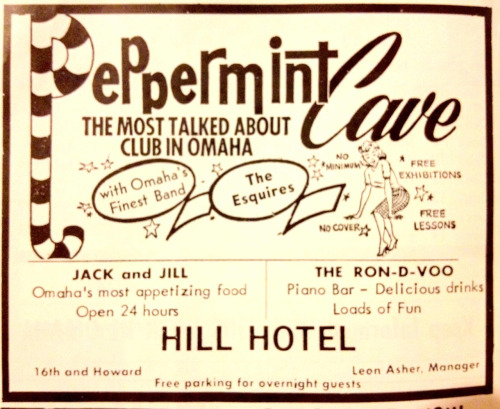
Years ago I happened upon this photo online when I first started writing about Omaha on Myspace. Maybe you have seen this early advertisement also? This was how I learned that the Peppermint Cave had been in the Hill Hotel. It may strike you as an odd pairing that at one time, one of the most well-appointed, towering hotels in Downtown Omaha had this very cave in its basement. For decades this underground haven was The Place to Be and now very little is spoken of it. Miss Cassette was more than intrigued. How had this club come to be, was it really a cave and why did it close? And this, fellow detectives, is where we swap out our sleek noir get-ups for our artful, spelunking attire.
The Investigation Begins
I fear I spoke too soon about the changing of clothes. We’ve got some evidence to sift through first but then we’ll get to the lanterns and the flashlights, I promise. After discovering that early Peppermint Cave advertisement and a bit of corroborating evidence found at the Omaha Public Library, I knew our investigation would begin on the southeast corner of Sixteenth and Howard, now the Kensington Apartments. I’ve written quite a bit about Sixteenth Street in my previous investigations to include The Case of the Curious Cricket Room and Burgess-Nash Company and The Case of Napier’s Booterie and the Securities Building. (I hope in time, to take Joe Knapp up on his offer of GIS mapping My Omaha Obsession, so that we can all easily track the connection to these incredible buildings. Wouldn’t that be swell?) This investigation, however, we will focus on the blocks further south on Sixteenth, where once was a strip of hotels.
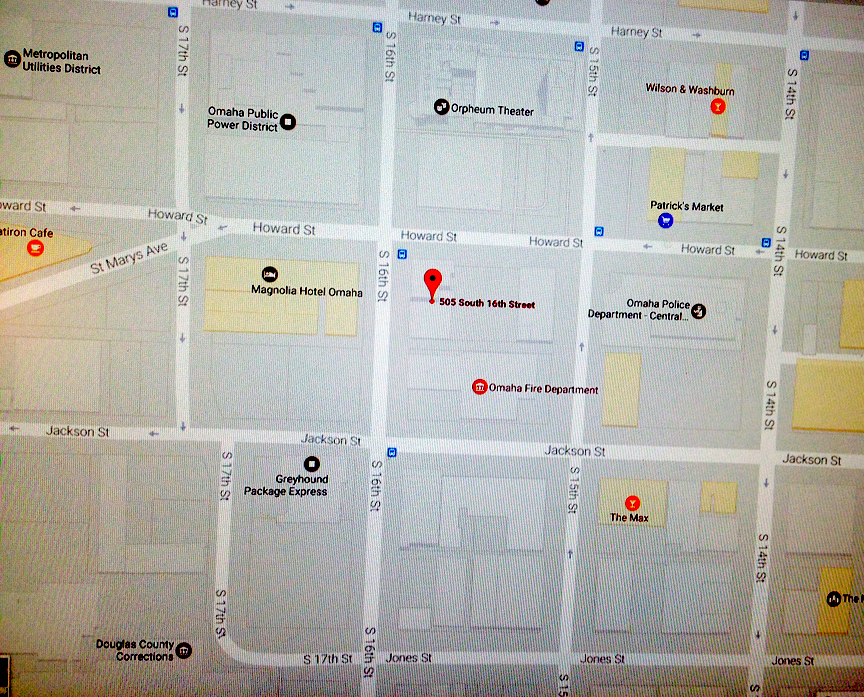
Current photo from Google Map. The cross corners of Sixteenth and Howard are densely filled, north of Howard with parking garages and south of Howard with the Kensington Tower Apartments and Magnolia Hotel. The classy, southern, “near-end” of the old retail strip of Sixteenth, in my mind. Sixteenth Street thins out considerably past Howard. But it wasn’t always that way, as we will see later. To get a real feel for this corner, walk or drive west from 13th on Howard. It sends shivers.
The Current State of Sixteenth and Howard
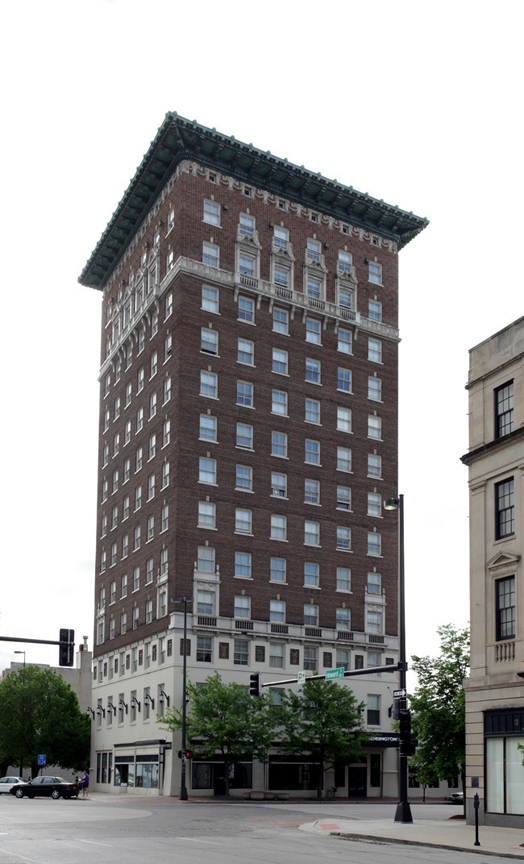
The Kensington Tower Apartments are found on southeast corner at 505 South Sixteenth Street. This photo is from the apartment website.
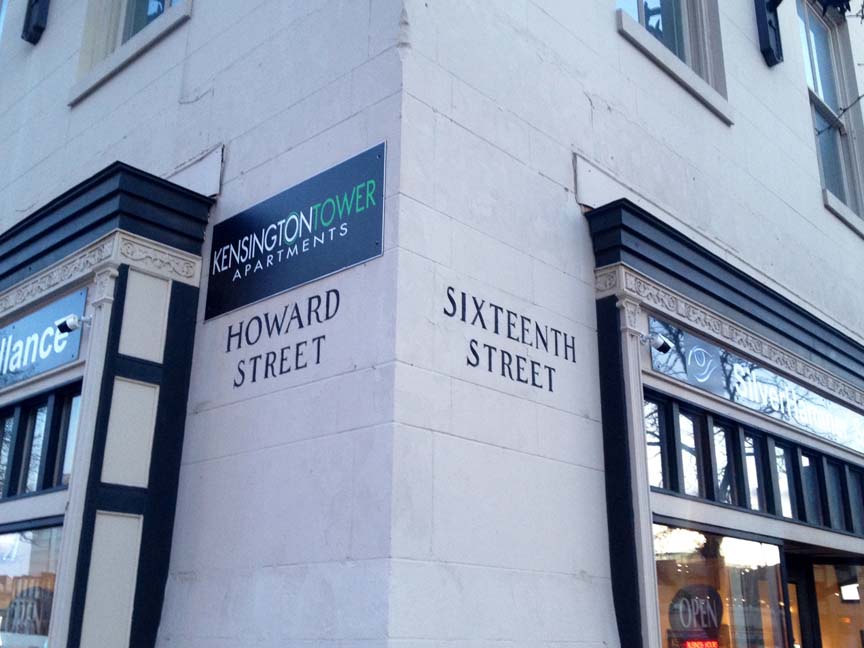
Street names still in use carved into the beautiful corner of the Kensington, a sad reminder that today’s signs cannot compare to craftsmanship of the past.
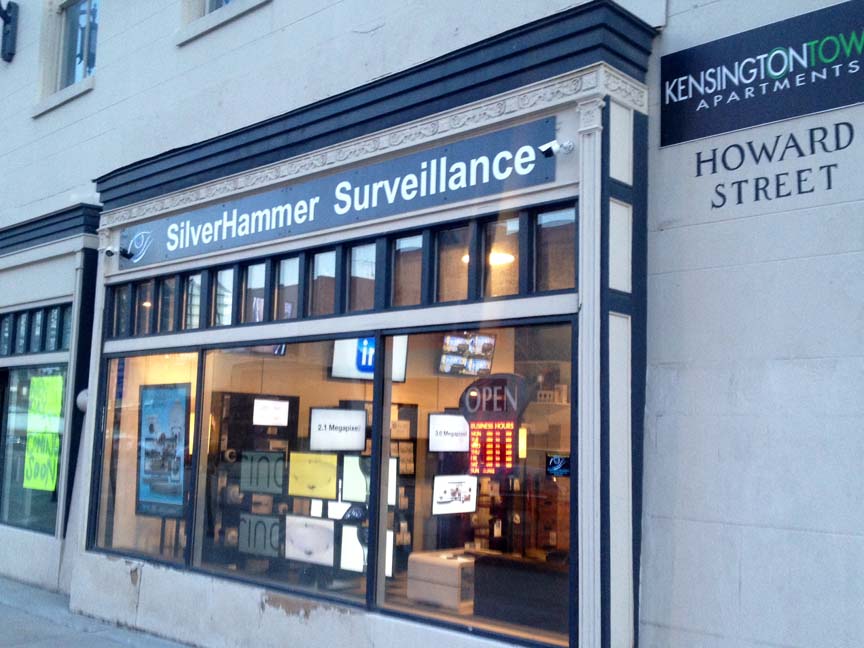
The Silver Hammer Surveillance business is found on the main level of the Kensington Tower Apartments. This particular window faces north. Their other window and door is actually on the Sixteenth Street side. Silver Hammer Surveillance is one of the coolest businesses in Omaha, second only to that 1940s private investigator’s agency that used to be on 51st and Leavenworth. When the gumshoe left his office, I about died. I continue to carry the torch for that elusive PI. Silver Hammer represents a business that I am afraid to walk into because I know, without a doubt, that my detective skills are not on the level…yet. They are a wealth of information. Have you seen this captivating shop of which I speak? http://www.silverhammersurveillance.com/index.html
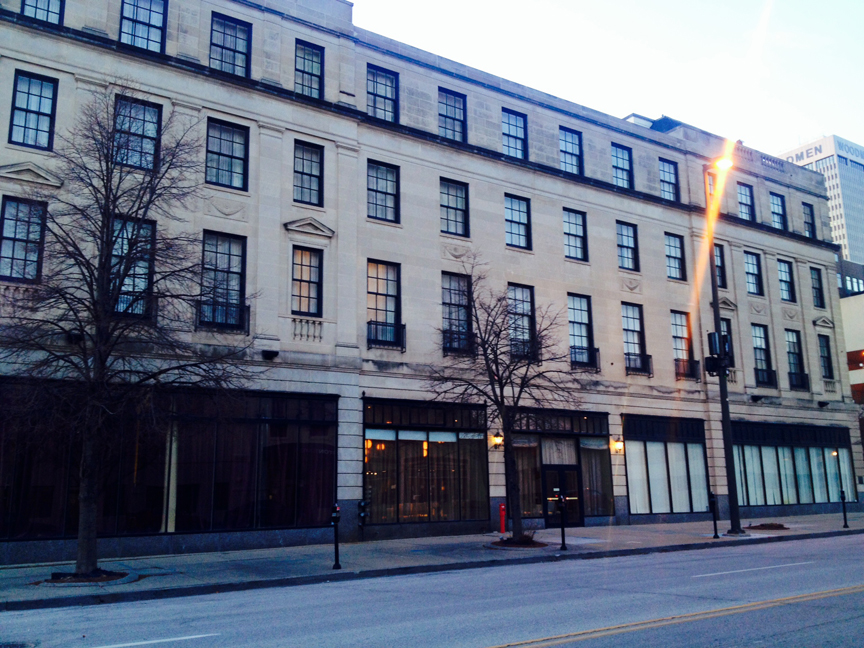
The dignified Aquila Court Building across the street at 1615 Howard Street now functions as the Magnolia Hotel. A favorite building of mine and someday I will return to do a proper investigation on this Lovely One.
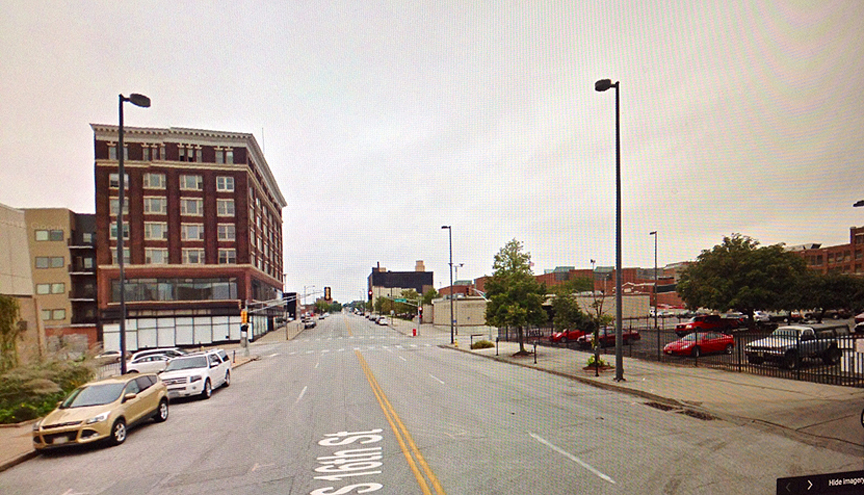
Photo from Google Map facing south on Sixteenth Street, toward Jackson. The Magnolia Hotel and the Kensington Apartments are surrounded by parking lots and vague concrete slab buildings until about Jackson Street, where the Union Plaza Apartments and the closed (or is it open still?) Greyhound Bus Station is located. For this reason, I say that Sixteenth and Howard is the classy near end of the once retail, hotel and club strip. But how did it all begin and where did the Cave connection fit into the puzzle?
Peter Iler and the Iler Grand Hotel
All pointers led to one Peter Iler, early Omaha whiskey distiller, who built the first hotel on the southeast corner of Sixteenth and Howard. I say first, because there would be an annex in time and then another hotel altogether at that corner.

From the Omaha World Herald. February 9, 1899. Iler Grand Opening.
The earliest mention, I could track of the Iler Grand Hotel was from 1898. The Iler Grand, Peter Iler’s hotel, opened to the public on Friday, February 10, 1899. The Grand Opening was the very next day. Now mind you, according to the “National Register of Historic Places Registration Form,” a fascinating 1988 report prepared by Lynn Bjorkman, Omaha City Planner, previous to building the Grand Hotel, Iler had built a three-story building containing stores and flats on this very corner in 1887. Later this building was converted for use as an “annex” to the Iler Grand Hotel. The Grand, according to Bjorkman’s research, was erected on the south half of the lot in 1897.
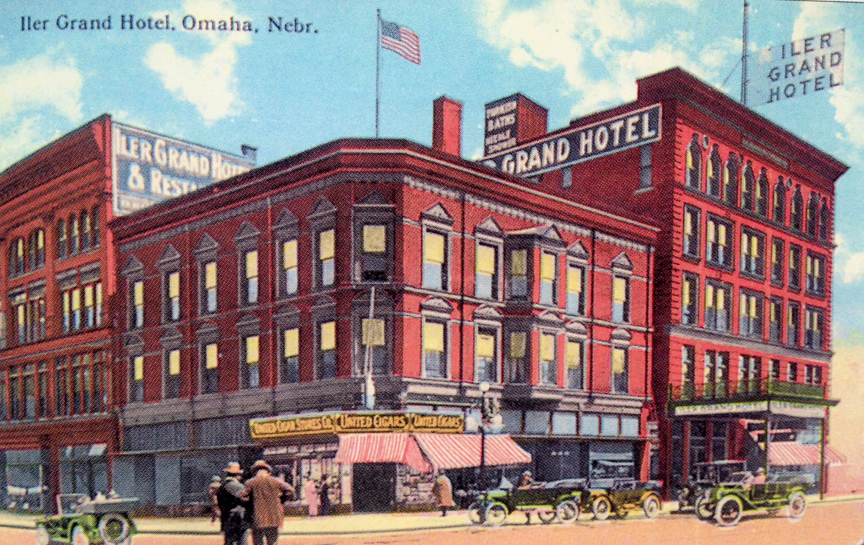
Iler Grand Hotel postcard, 16th and Howard in 1916. From the Burnice Fiedler collection. Taken from the Greetings from Omaha Nebraska book compiled by (the fabulous) Kristine Gerber and Paula Steenson. This postcard further illuminates the smaller building originally settled on the actual corner, with the Iler Grand built just to the south.
The Iler Grand Baths
Some of you impatient types might be wondering what all of this has to do with the Cave and just when will we get to the Cave? Here, my anxious friends, is the connector piece–the evidence by which we begin our case in full. In late February of 1899 Peter Iler unveiled “The Iler Grand Baths.” These Grand Baths were in the basement of the hotel, a pattern of underground environs on this corner that we will soon add to our dossier. Trust me and tuck this bit of information under your fedora.
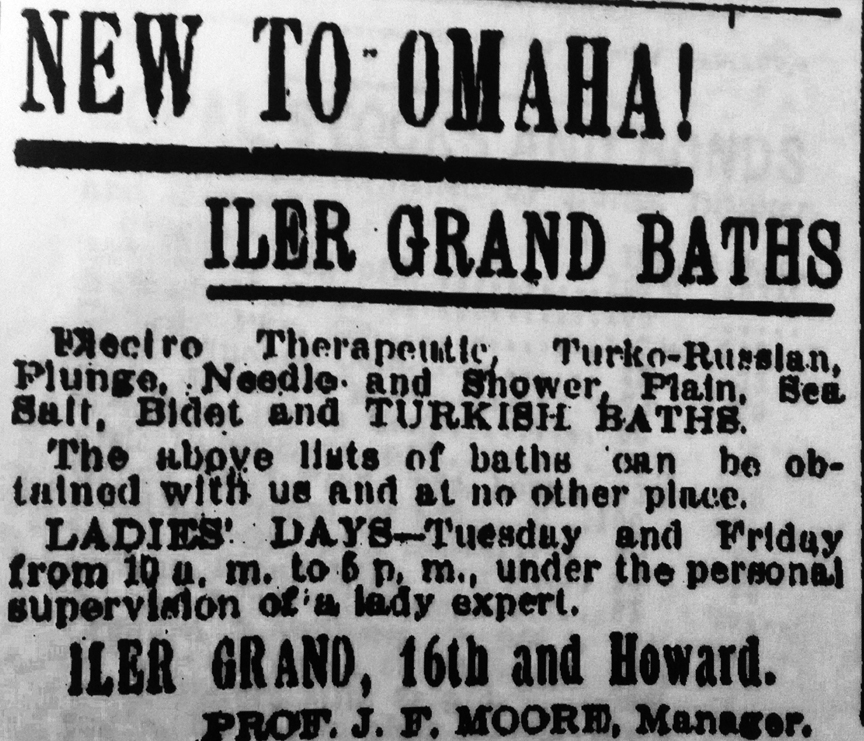
From the Omaha World Herald. February 24, 1899. The concept of public bathing, cleansing and relaxation wouldn’t have been shocking to Omahans at this time, although, now that I ruminate on it, we’ve always been a rather modest bunch. I shudder to think. By in large the idea of taking steam or dry heat, followed by a plunge in a cold pool after the hot rooms was thought to ease ailments like rheumatism and arthritis. It was also a social gathering. Venturing to natural hot springs was also gaining popularity. Public bathing, (although the Iler wasn’t free) was offered in larger cities, at a time when rising concern over cleanliness conflicted with the average American’s ability to access a full bathroom.
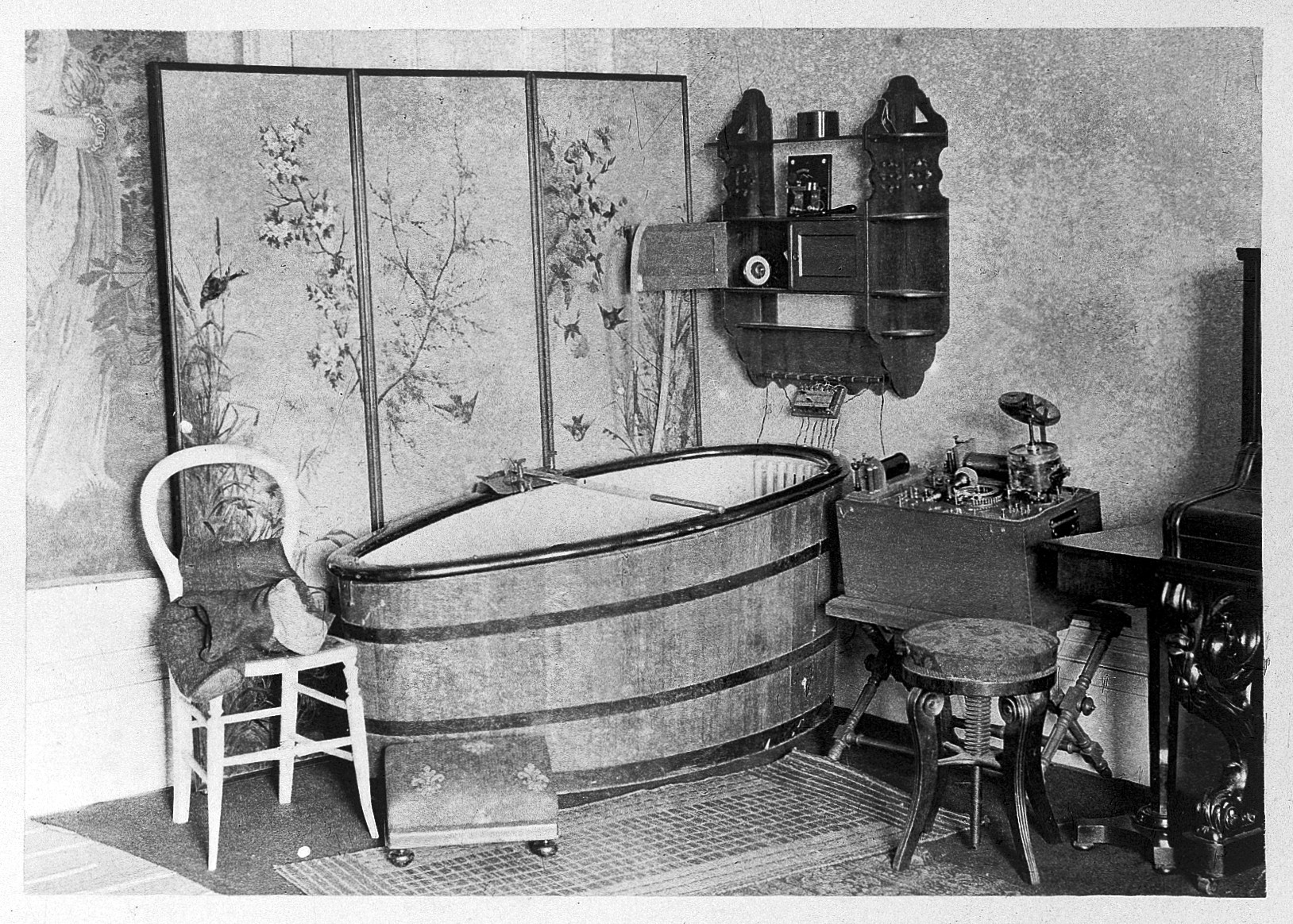
Hydro electric bath 1892. Meanwhile electrotherapy was becoming a known alternative medical treatment. Using energy, this bath was charged with electricity or electrically charged water. Hydroelectric baths were used as a tonic. Apparently the combination of electrical current with baths enhances their tonic and sedative effects. The Iler Grand Bath boasted of Electro Therapeutic, Turko-Russian, Plunge, Needle and Shower, Plain, Sea Salt, Bidet and TURKISH BATHS. This array would have been seen as more of boutique spa of its day, rather than a bathhouse. “The above lists of baths can be obtained with us and at no other place.” Ladies’ Day was “under the personal supervision of a lady expert.”
The Iler Grand Hotel would become a leading Omaha hostelry in its early years, the Grand Dame surviving thirty-four years in the business. Other accounts say fifty years total, if you take into account the years of the smaller flats—although to me, not a real hotel. The Omaha City Directory listed the Iler Grand proper address at 507 South 16th Street. Also listed was a Grand Barber Shop. I am a hopeless devotee of formal hotel barbershops and cigar stores. Rome Miller, of the Hotel Rome, (incredible name) would go on to operate the Iler Grand for fifteen years.
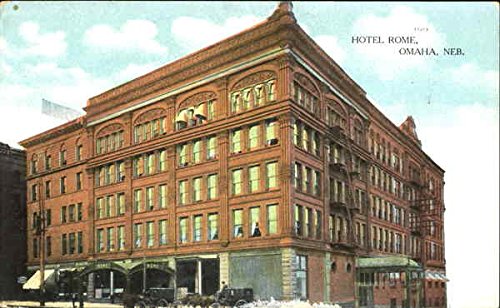
Hotel Rome postcard. Sixteenth and Jackson, just south of where the Iler Grand used to stand.
According to the Omaha World Herald, Fred Castle and P. W. Mikesell were at the Iler Grand helm in 1918 but were not owners. Omaha: The Gate City and Douglas County, Volume Two by Arthur Cooper Wakeley offered a bit of conflicting information. According to his research, Fred A. Castle had leased the Iler Grand for five years, leaving to open the Castle Hotel in 1915. I have long been obsessed with the old Castle Hotel at 632 South Sixteenth and there is surely an investigation to come in the future. This hotel, like so many Omaha treasures was razed in the early 1970s. I have really gone down a rabbit hole and I do plan to right us. It would all be a bit too fatiguing if it wasn’t so engrossing. And I do hope you find it the latter.
***UPDATE***Reader, Robert Hunter wrote in and sent these fantastic photos. He wrote, “I have no clue how my grandparents got this brush. Could even have been from my great grandmother (I assume it was my grandmothers because it was with other things that were hers but it could have belonged to her mother too seeing as how this brush has to be around 100 years old).”
Thank you, Robert!
Closing of the Iler
I found evidence that J. W. and L. H. Hill had been the actual owners of the Iler Grand Hotel for a number of years. In 1919 the pair also took over the hotel management, according the Omaha World Herald.
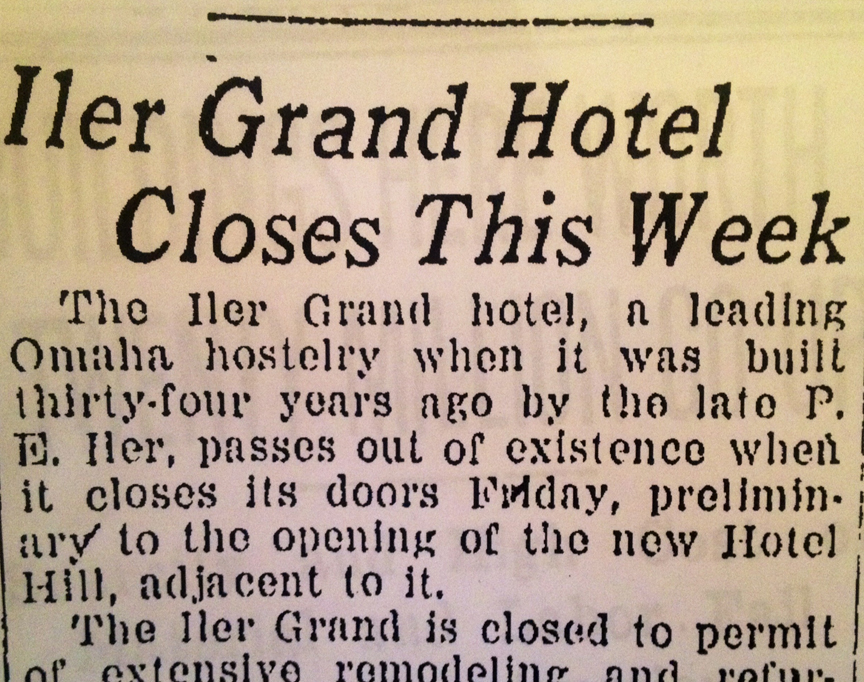
April 29, 1920, the Omaha World Herald announced the closing of the Iler, “Preliminary to the opening of the new Hotel Hill, adjacent to it.” At that time the Iler Grand was to be extensively remodeled and refurnished for two months. “After which the five upper floors will be annexed to the Hotel Hill. The lobby floor will be converted into store rooms.”
John and Alan McDonald
“National Register of Historic Places Registration Form” stated that Omaha businessmen John W. and Lem H. Hill began construction of the Hill Hotel in the fall of 1919. The pair had hired the architectural firm of John and Alan McDonald. The McDonalds’ practice spanned a total of 70 years, with many residential and commercial commissions from upper-crust Omaha—the First Unitarian Church, Joslyn Art Museum, Beth El Synagogue, to name but a few of their more prominent designs. The hiring of the well-regarded McDonalds signifies that the Hills wanted a beautiful, prosperous architectural composition—formally leaving World War I behind, a beacon to the well heeled. I might be making that part up.

So gorgeous. Detail of the Hill Hotel. Photo from the Kensington Apartments website.
The Hill Hotel
From an Inventory of Historic Omaha Buildings prepared by Landmarks Inc. in 1980, 501 S. Sixteenth Street began life as the Hotel Hill as was the trend in those years. (The name would be found interchangeably through the investigation.) It is dated10-10-1919, although not opened until a year later. At a cost of $250,000, the Hill Hotel was in the Neo-Classical Revival (popular from 1880-1920) style. The “National Register of Historic Places Registration Form” further describes the hotel using terms Colonial Revival and Georgian Revival architectural styles.

I would love to get inside this building and onto the roof.
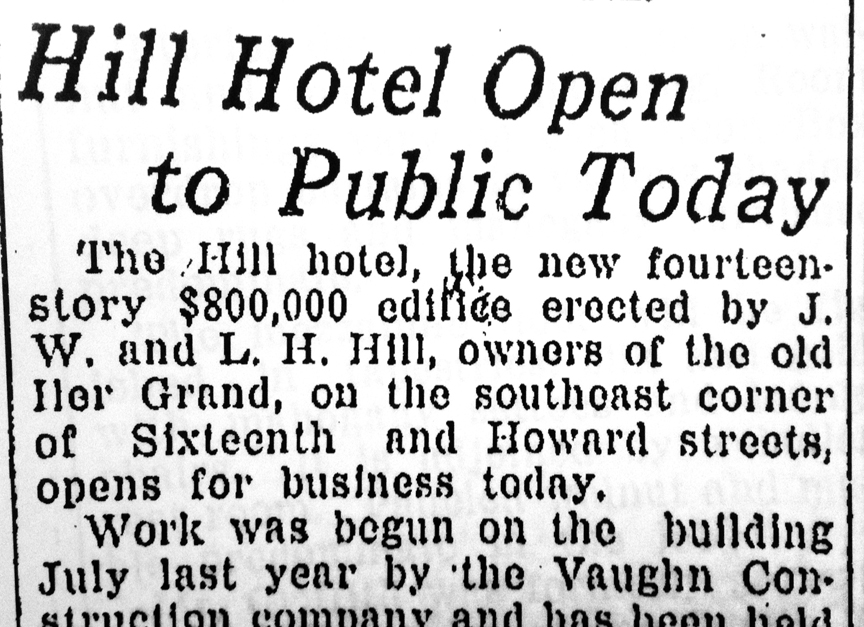
Omaha World Herald Sept 2, 1920: “The Hill Hotel, the new fourteen story $800,000 edifice” opened for business. The building was begun in July of 1919 by the Vaughn Construction Company and was “held up four times by strikes.” At the time of the opening, the Hill Hotel had 75 of the 200 rooms completed. Within ten days the lobby, the mezzanine floor and the basement were to be finished. C.E. Griffith, manager, formally of Castle Hotel, was quoted as saying it would be weeks before the dining rooms and cafes were ready.
Hints at Omaha in 1920
From Omaha: A Guide to the City and Environs, compiled and written by the Federal Writers’ Project of the WPA from 1935 through 1939, I located that the population of Omaha had grown to 191,605 by 1920. “A building boom was in progress, with more buildings erected in 1919 and the early years of the twenties than at any previous time.” The striking feature of the boom was the increase in apartment houses and hotels–to include the Conant, Castle, Blackstone, Sanford and Hill. By the time the book was written the Hill Hotel remained one the tallest building on the Omaha skyline, along with the Fontenelle and Paxton Hotels, the Union Pacific Building, the Medical Arts Building and the Woodmen of the World Building. The Aquila Court building, across the street, would be erected in 1923.
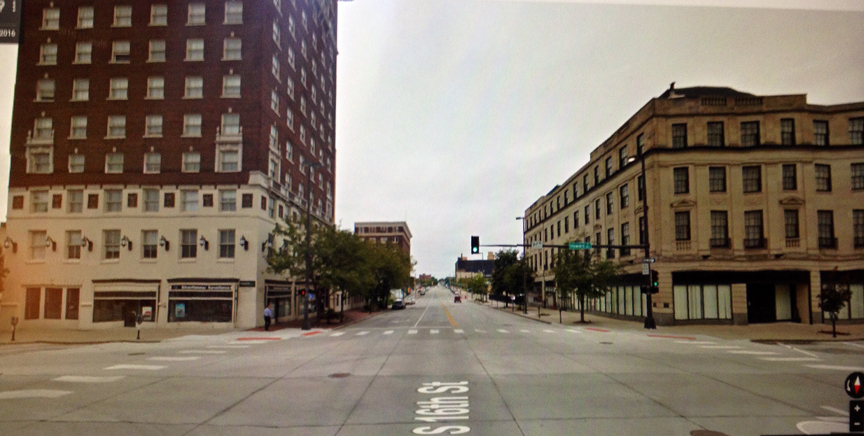
The Hill Hotel and Aquila Court Building, as they look today. Sixteenth Street facing south.
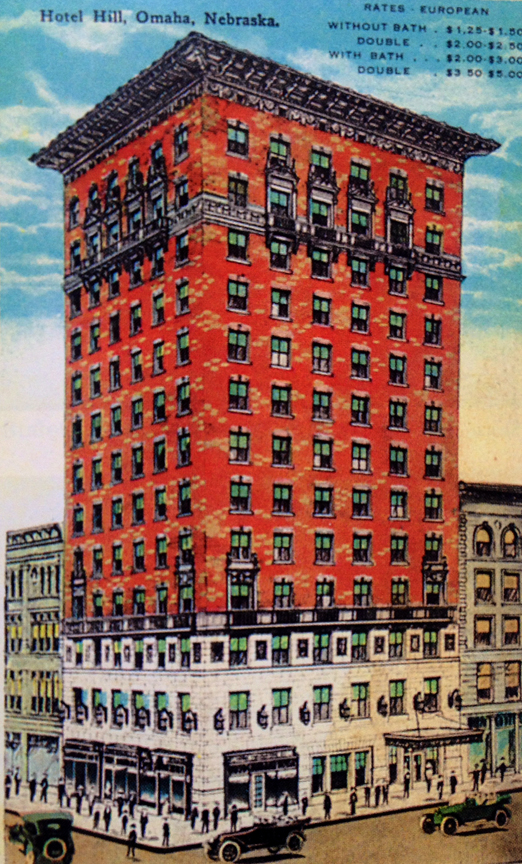
Hotel Hill postcard from 1925. From the Burnice Fiedler collection. Taken from the Greetings from Omaha Nebraska book compiled by (the fabulous) Kristine Gerber and Paula Steenson. More photos later but just to give you an early idea of the Hotel Hill.
Hotel Hill Turkish Baths
I was delighted to find the new basement of the Hotel Hill used as a bath and spa like the Iler baths before. The Omaha City Directory of 1920 lent the clue, vaguely describing the: “Hotel Hill basement: Hotel Hill Turkish Baths.” I was not entirely sure if these Turkish Baths were in the newly erected hotel basement or the annexed area to the south, which had been the Iler Grand Baths. One might like to assume that the Hill Turkish Baths were in the annexed area, as they had already been established. Maybe you should jot that down in your little leather-bound pocket notepad. We’ll be turning over this theory later.
The Jack and Jill Coffee Shop
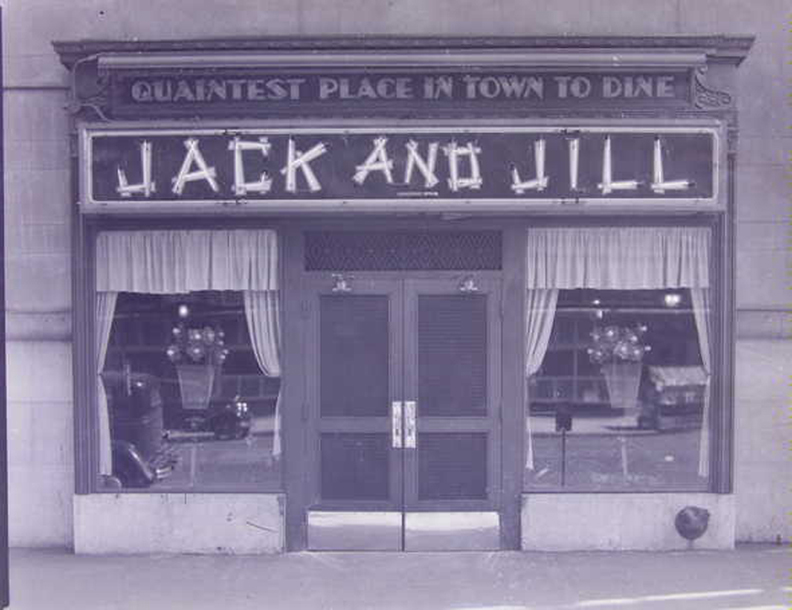
Jack and Jill Coffee Shop. The Quaintest Place in Town to Dine. Get it? Jack and Jill went up the hill. In October 7, 1928 the new Jack and Jill Coffee Shop was announced in the Omaha World Herald. They were to open in the Hill Hotel the very next day under the management of Horace Humphreys. Love the name. The futurist wall decorations (?) were designed and painted by Bernard Szold, the director of the Omaha Community Playhouse. There was “brightly colored broken-tile floor and wrought-iron light fixtures.”
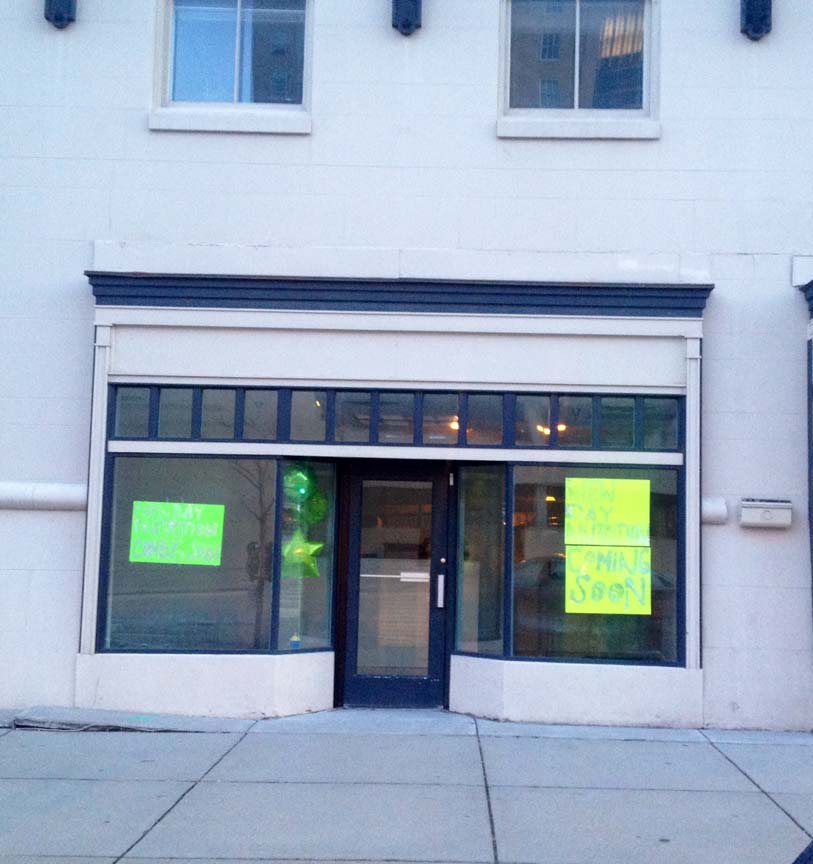
The current look of where I believe the Jack and Jill stood. This bay faces north on the Howard Street side of the building.
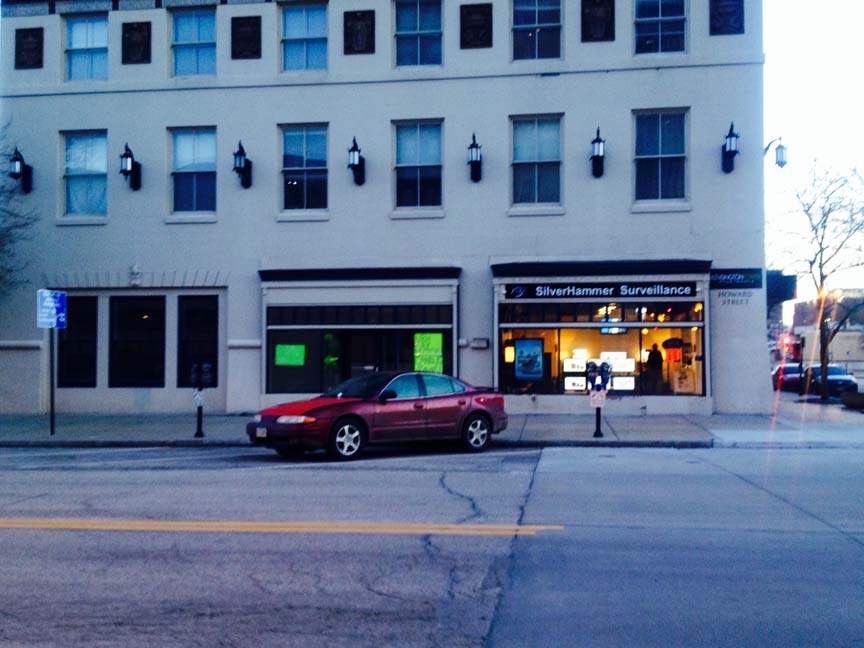
The Jack and Jill Coffee Shop, occupied the bay just east of what is now Silver Hammer Surveillance.
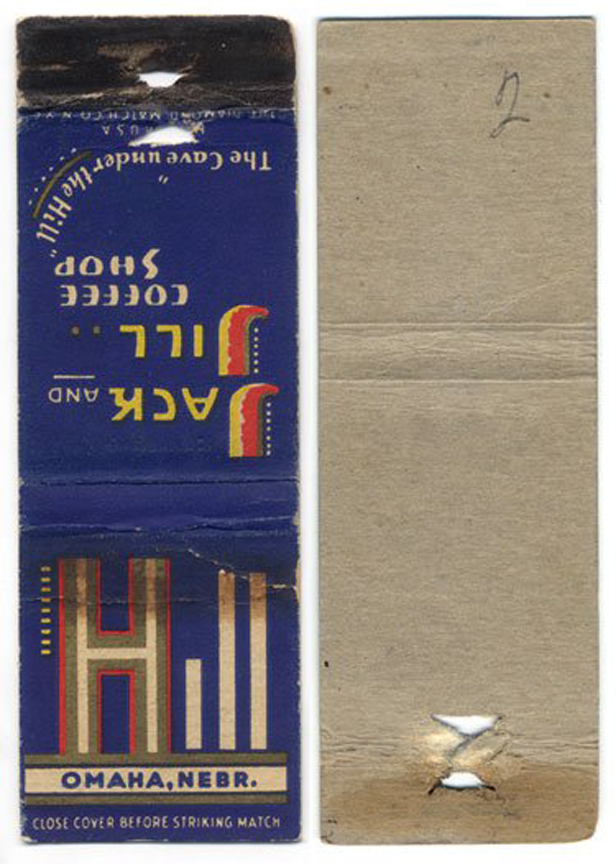
Jack and Jill matches, as shown for sale on Ebay. As if all of that wasn’t enough, one of the novelties of the Jack and Jill Coffee Shop was an old-fashioned well and an oaken bucket, which served as the ice water tap. Waitresses would stand there and draw the bucket up and down into the ice water, filling drinking glasses with the water therein. Hmmmm…sounds kind of delightfully…dirty. Well I suppose it was all very in keeping with that childhood rhyme.
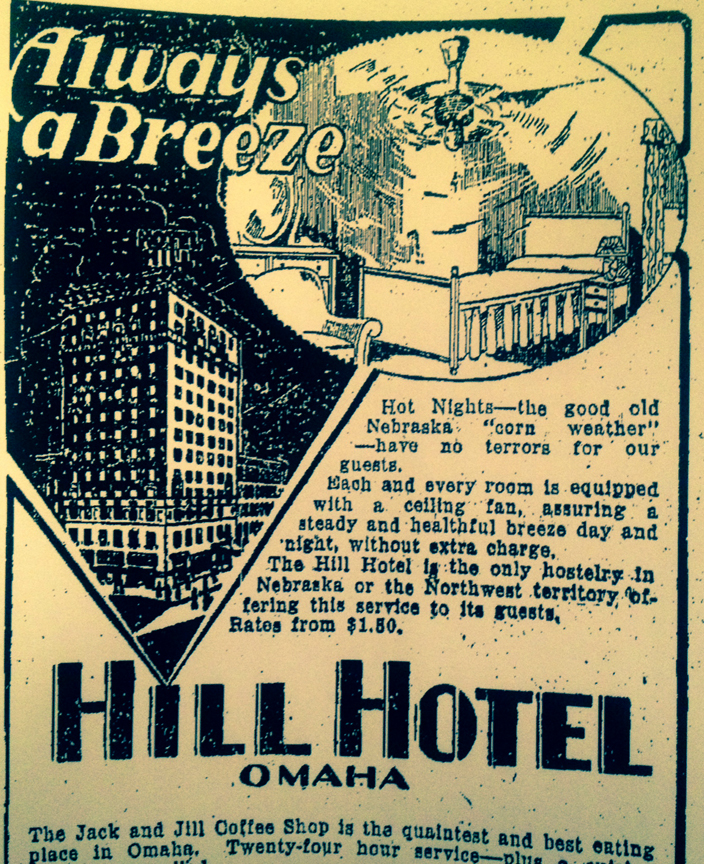
July 28, 1929. Always a Breeze ad. This is maybe my favorite advertisement of all time or of this week. “Hot Nights—the good old Nebraska ‘corn weather’—have no terrors for our guests.” What? So disturbing. By 1929 Samuel Josephson had taken over the management of the Hill Hotel. A long time hotelier, Josephson also operated the Westgate Hotel of Kansas City. The Hill Hotel advertisements improved greatly in that year.
Side Note and Apologies about My Wanderings
If my lips were given to setting in a grim line when things went awry, this might be that dismal occasion. Even as I type, I am quite heartbroken to deliver this news… but I must. You have been so kind to allow me to do my obsessing and fuss around and dragging things about till I am quite happy. But as usual, we have run on much too far ahead or rather, I have gone to deeply. We must leave the Hill Hotel descriptions, though I do adore them, with a promise that I will complete a full investigation on the hotel– because I have truly fallen in love. For the sake of brevity, a quality, which I normally do not support, and my sudden trepidation that we will never reach the Cave, let us advance to the business at hand. (You cannot believe how torturing this grown up brevity can be.) One clue always leads to another….
The New News on Sixteenth Street
If you have not donned your spelunking gear yet, you could just stay in your trench coat if you are more comfortable but you’ll probably want some sensible shoes from this point on. I am generally opposed to those things. At some point on the trail, I spied a brief building permit, from the Omaha World Herald dated December of 1937.

Building permit to alter room for $250. About $4,225.00 by today’s standards. Could this have been the origin of the Cave club? Not long after, on December 26, 1937, the New Marine Bar opened in the Hill Hotel. I am not sure if this bar was in the basement or on the main floor.
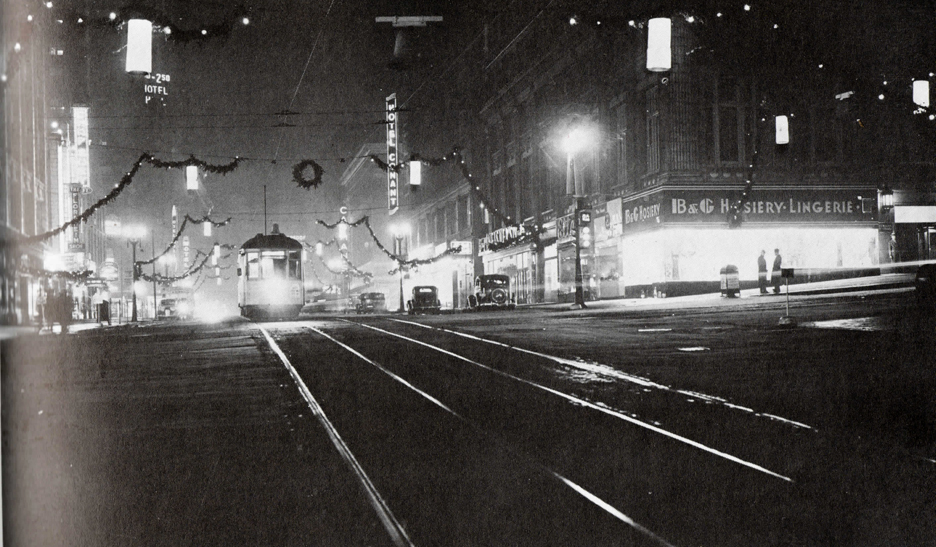
December 15, 1937. Fantastic photo from this time period facing south down Sixteenth Street with Farnam being the cross street. This gives a real feel of this time period showing the Christmas decorations and how active Downtown Omaha used to be. Even at night. Photo from Streetcars of Omaha and Council Bluffs by Richard Orr. In the upper left hand side one can spot the partially obscured Hill Hotel sign high in the sky. States the overnight rate and Hotel Hill. I want to walk into this photo and live for a night, indulging in the glorious signs of old Omaha, when people understood quality extended to font.
The Cave Under the Hill
The first mention I uncovered of the Cave was from the Omaha World Herald, dated January 21, 1938. The advertisement proclaimed, “Opening Saturday. Omaha’s Newest and Most Unique Spot! The Cave Under the Hill.” I instantly loved the name. It really conjured a whole look and feel, so unlike the minimalist bar names of today. This detective wondered if the Cave Under the Hill was just a good play on the Hill Hotel or if the name had a significant cultural meaning at the time. From what I could turn up, the old Brownies books and stories made mention of a cave under the hill. This might be a stretch.
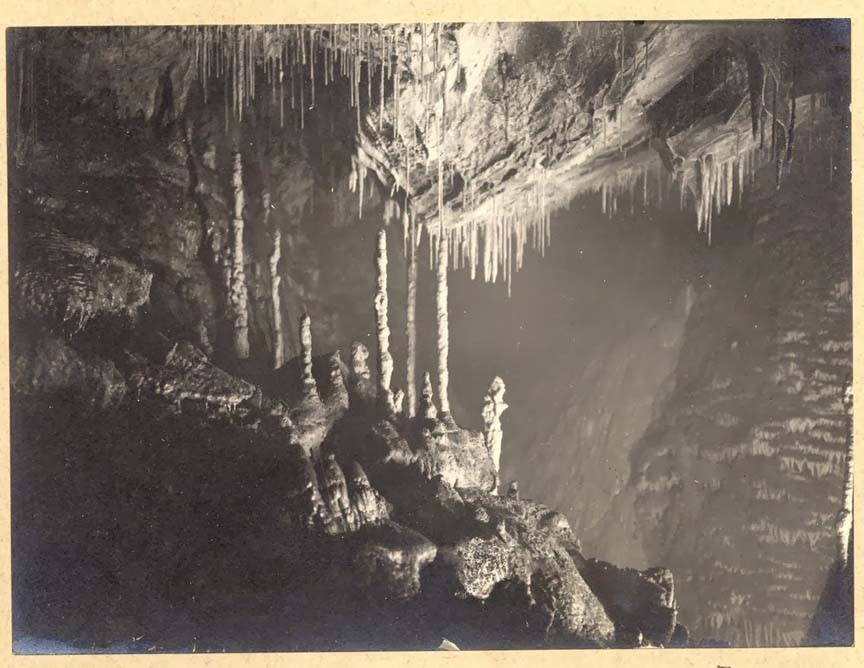
Meanwhile I’d stumbled across these spectacular shots from Swildon’s Hole, Priddy, Mendip Hills, Somerset.1921. Images from the British Association for the Advancement of Science photograph collection held at the British Geological Survey. Photographs were taken by J.Harry Savory. Which only serve to prove that we humans have been obsessed with caves since the beginning of time.

Breathtaking cave. Swildon’s Hole, Priddy, Mendip Hills, Somerset.1921. Images from the British Association for the Advancement of Science photograph collection held at the British Geological Survey. Photographs were taken by J.Harry Savory.
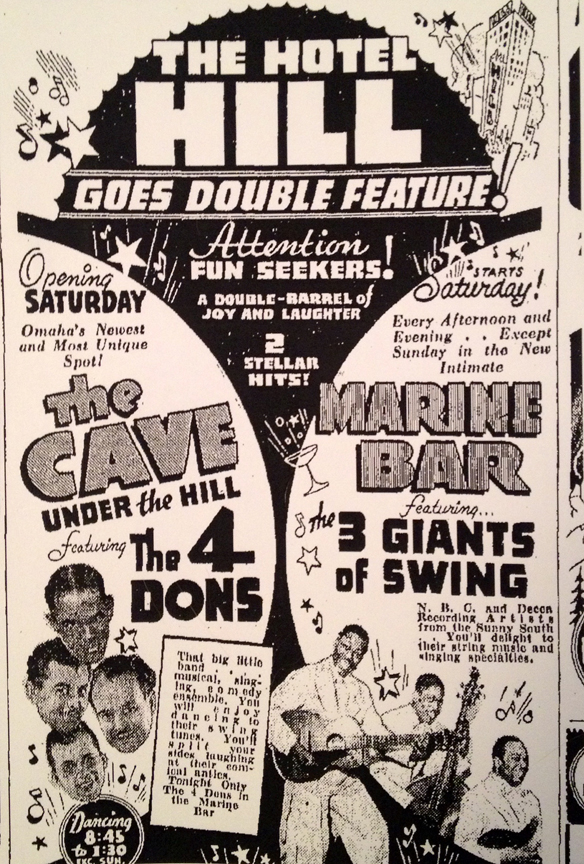
January 21, 1938. The Hotel Hill Goes Double Feature. I realized later the Cave Under the Hill had its name dropped but briefly in the terrifically odd book, The Face of the Naked Lady: An Omaha Family Mystery by Michael Rips. Now doesn’t that sound just like something you might like? It is so interesting. My galpal, Amanda Lynch, of Jackson Street Booksellers’ fame, gave it to me as a birthday gift one year.
The Cave Under the Hill became The Spot for live music and dancing from its inception in 1938. At that time the club was entered through the main Hill Hotel front doors facing Sixteenth Street. I imagine the clientele traipsed through the lobby nightly and went through another doorway where the music-loving clientele descended the stairs to a low-ceilinged basement. It would appear from photos that there were many different areas in the club–more on that in a bit.
The Music and the Time
The Four Dons played the Cave frequently in 1938 and by April, had been renamed The Cave Cut-Ups. The 3 Giants of Swing playing at the Marine Bar were a southern swing band off of the Decca label. They were later featured in early African American movies. Big band jazz and swing music was very popular at this time. Think Duke Ellington, Benny Goodman and Glenn Miller. “Jazz combos” were growing in number and primarily African American– the combos just barely starting to mix racially mix due to segregation. There were many popular radio singers like the Andrews Sisters and Bing Crosby, some incorporating a humor into their acts like an old variety show. (Because of my grandmother’s tutelage, my all-time favorite from this period is Miss Billie Holiday.) Couples’ dancing was Very Big in the late 30s and there were a number of great dances taking their influence from African Americans culture. Think the Lindy Hop, later the Jitterbug, the Foxtrot and the Big Apple. Meanwhile the hillbilly music of the 1920s was being re-marketed as “country and western.” It would appear that this genre of live music was not offered at the Cave Under the Hill. The Great Depression was nearing its end and Prohibition was over in the States. The most likely all white Omaha patrons loved to gather for that live music and the now legal giggle water.
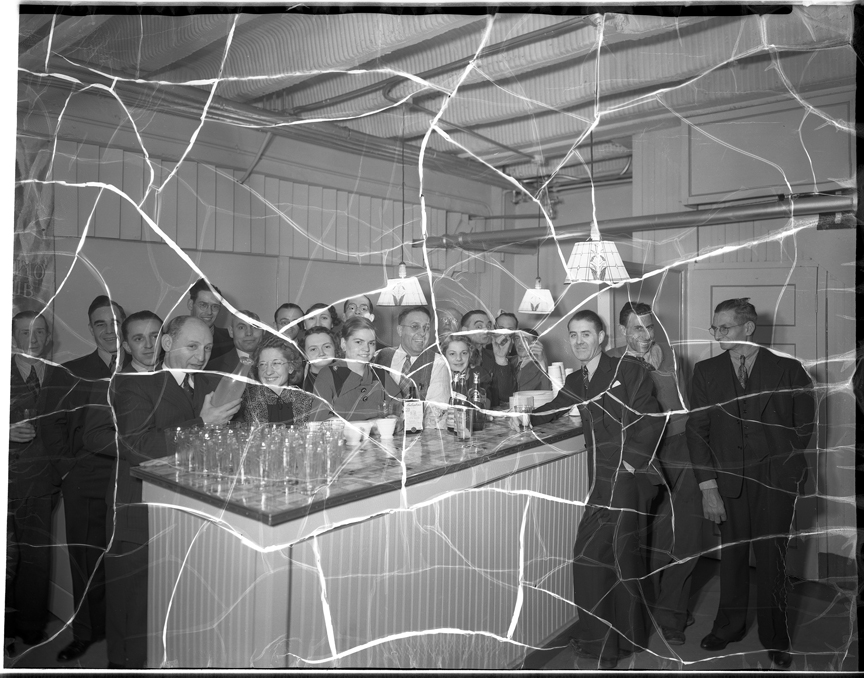
In January of 1938 Reitz Sales and Service business, at 1818 Douglas Street, had their annual company party at the Cave Under the Hill in the Hill Hotel. Here the company are seen drinking and having a good time. (Photo courtesy of the Bostwick-Frohardt/KM3TV Photography Collection at The Durham Museum Photo Archive). This looked like a basement to me, albeit, a nice one for the 1930s, but I wasn’t yet picking up the Cave Under the Hill feel.

From 1938: Omaha’s Glamour Spot ad. Cocktail dancing from 2 to 5:30. “WHOOPLA.”
Other Clues to the Cave
Omaha: A Guide to the City and Environs But what really caught these WPA writers’ eye was the Cave Under the Hill. “The Cave Under the Hill is open from 4 pm to 1 am. The Cave is one of the most popular downtown nightclubs. Drinks of all types are served. Music is furnished by a small orchestra.” Other “most frequented clubs” in this corridor were the White Horse Inn in the Regis Hotel on 16th and Harney and the Rome Bar in the Rome Hotel on 16th and Jackson.
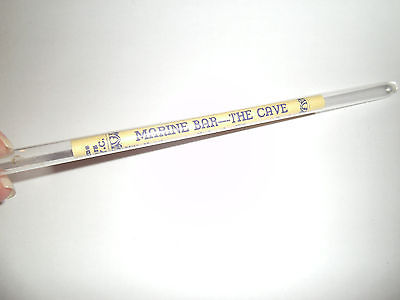
Marine Room–The Cave Glass Swizzle Stick from the Hill Hotel as found on Ebay. The flip side read Grand MacNish Scotch.
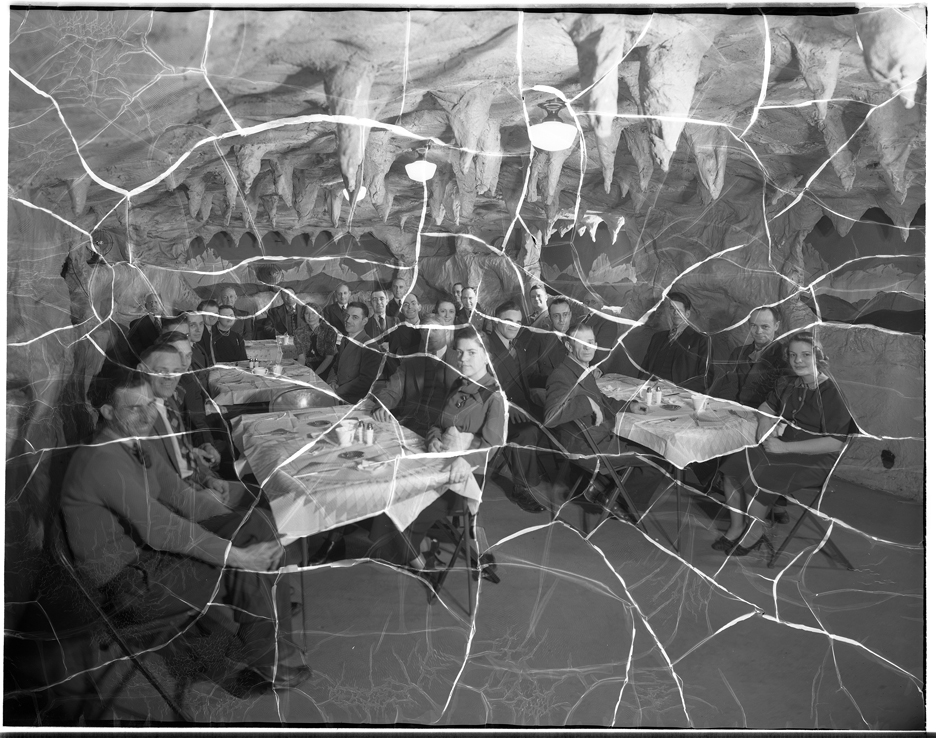
More from the Reitz Sales and Service Annual company party at the Cave Under the Hill. Now this was starting to look more like a cave. I was so excited to find this photo. Look at those stalactites hanging from the ceiling of the cave. Just amazing. (Photo courtesy of the Bostwick-Frohardt/KM3TV Photography Collection at The Durham Museum Photo Archive).

Advertisements for four great Omaha business that I had to include because they’re all so cool. Dixon’s and Peony Park. Desirous. I need to point out that the Marine Bar had “Community Singing,” which Miss Cassette favors immensely.
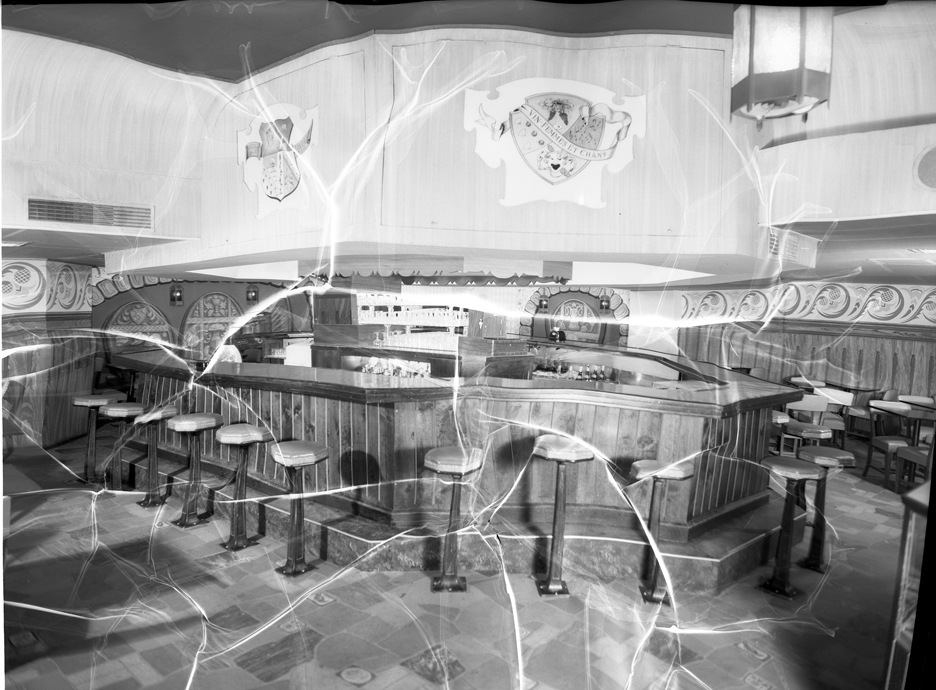
The Cave Under the Hill basement bar. Overhead crest reads, “VIN-FEMMES-CHANT” which translates to “Wine, Women and Song”. (Photo courtesy of the Bostwick-Frohardt/KM3TV Photography Collection at The Durham Museum Photo Archive). February 25, 1938. The scroll cuts around the bar remind me of the 1941 Cassette kitchen cabinets in our house. The wrought iron lanterns, the crests, the English feel and faux stone work over the rounded doorways struck me as being a bit thrown together. After weeks of mulling, this detective began to believe that the Cave Under the Hill was in a Hobbit-fantasy novel-J. R. R. Tolkien theme. When I found The Hobbit was published in 1937, I speculated that this was where the Cave Under the Hill gathered its early decor.
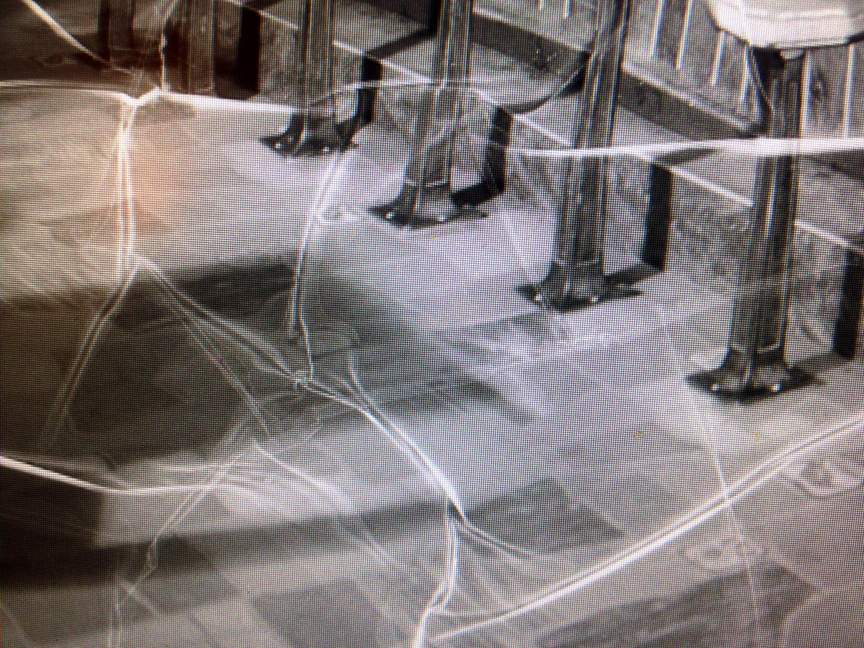
I adore the linoleum floor and the great bar stools. Very similar to our basement floor. I have a thing for original linoleum tiles and flooring.

The Cave Under the Hill, view of the bar and several small tables with chairs. In the back corner is a small stage for a live band. (Photo courtesy of the Bostwick-Frohardt/KM3TV Photography Collection at The Durham Museum Photo Archive). February 25, 1938. The Cave Under the Hill was mentioned frequently in the Dance Spot News column of the Omaha World Herald.
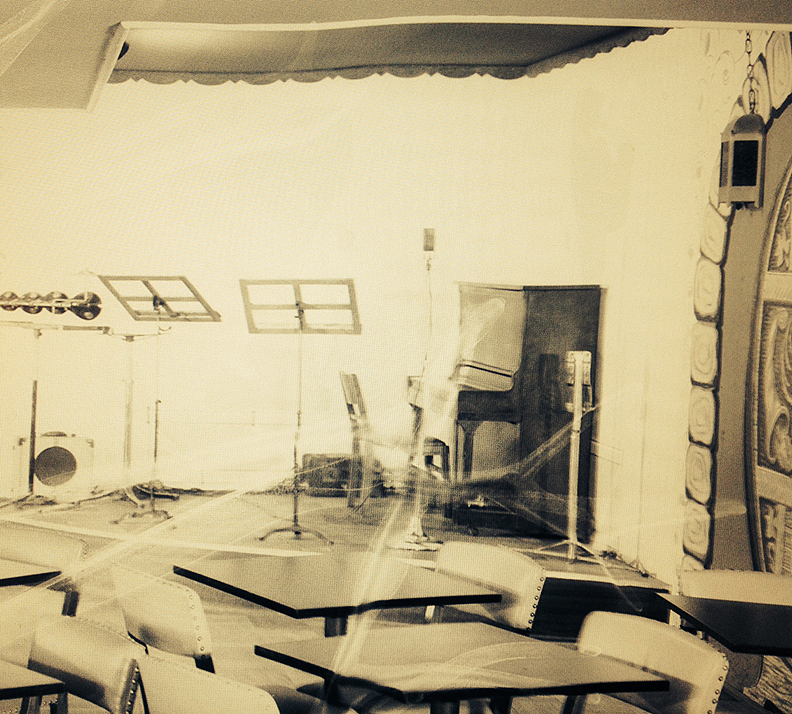
A closer look at that stage, scroll work and painted Hobbit door. (Photo courtesy of the Bostwick-Frohardt/KM3TV Photography Collection at The Durham Museum Photo Archive).
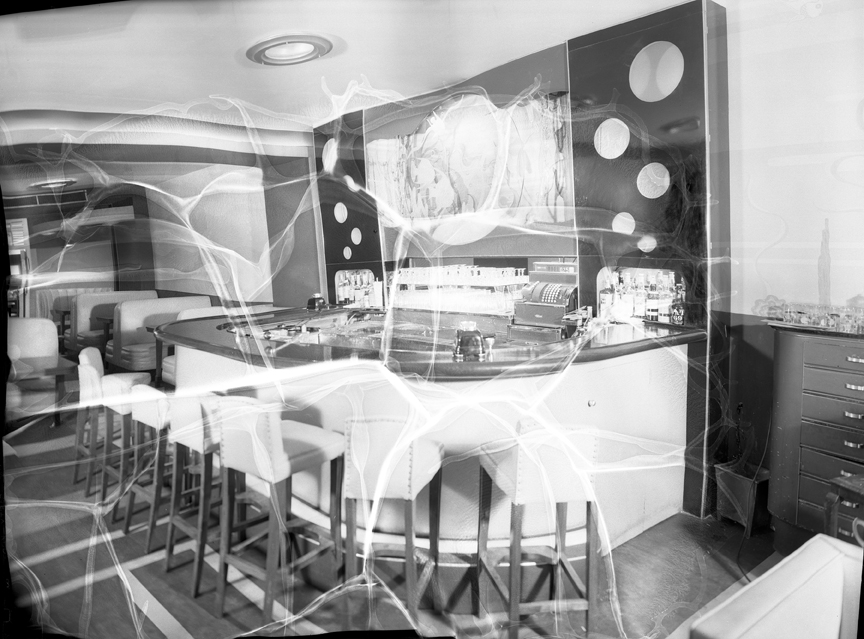
Now this photo of the Cave Under the Hill is also dated 1938 but it is so very modern. I was confused. Was this the other side of the bar? Was this perhaps taken in the late 1940s through the 1950s instead? I think the date was a mistake. These must have been very contemporary digs for the time. I would very much enjoy spending time here. (Photo courtesy of the Bostwick-Frohardt/KM3TV Photography Collection at The Durham Museum Photo Archive).
The Concept of Cave as Club
There is a bit of inherent mystery about the Cave Under the Hill. The name is genius, really. This detective had a hunch that there must have been other cave clubs popping up in the States during this time period based on my discoveries of the Forrest Glen clubs and woodland themed clubs I came across in my The Curse of the Clover Leaf Club article. Miss Cassette loves a good theme for a restaurant, tearoom or cocktail lounge, especially during the 30s through the 60s and I, obviously, am not alone in that. As I could have guessed because caves have always fascinated people, the cave nightclub concept lent itself nicely to an intimate, party atmosphere. It’s all about the mystique.

One of the earliest, coolest gathering spots I found was this Masonic Grand Lodge of Arizona meeting in the cave in the mine of the Copper Queen Consolidated Mining Co. at Bisbee, Arizona, Nov. 12th 1897. Photo by A. Miller. Yes, I said Masons. Check out this link for more about the potential Mason—Cave connection. http://thatoregonlife.com/2016/06/malheur-cave-easily-creepiest-cave-oregon/
I discovered an absolutely immortal looking environ from old Washington, D.C. The Club Crystal Caverns was an African American built and owned nightclub. First established as the Night Club Bohemia, the hot spot was soon patronized by black Washington’s elite. From the 1920s through the 1940s, they reigned as the Club Crystal Caverns. I wish I could have gotten a look for myself.

Washington, D.C. The Club Crystal Caverns. Just take it all in. Those headdresses, the ceiling, those shoes and the man who could be from 2017. Heaven.

Bohemian Crystal Caverns in Washington, D.C. This is the coolest thing you will look at all day. Imagine the acoustics? I just noticed the pirate faces in the cave walls.
It wouldn’t take long to locate Canadian leads on the same trend. The Cave Supper Club originated as a Western Canadian chain of nightclubs in 1935. The Vancouver location survived four decades and successfully dished out drinking and live entertainment.
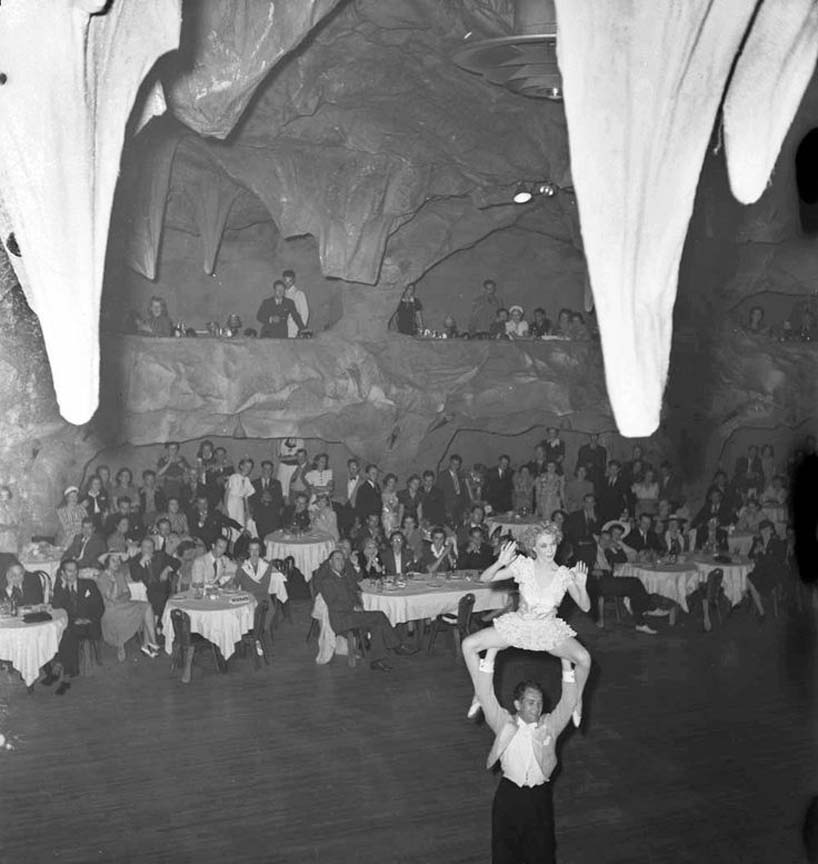
The Canadian Supper Club Night Cave performers. Just look at that glorious site. Now that’s a cave club.
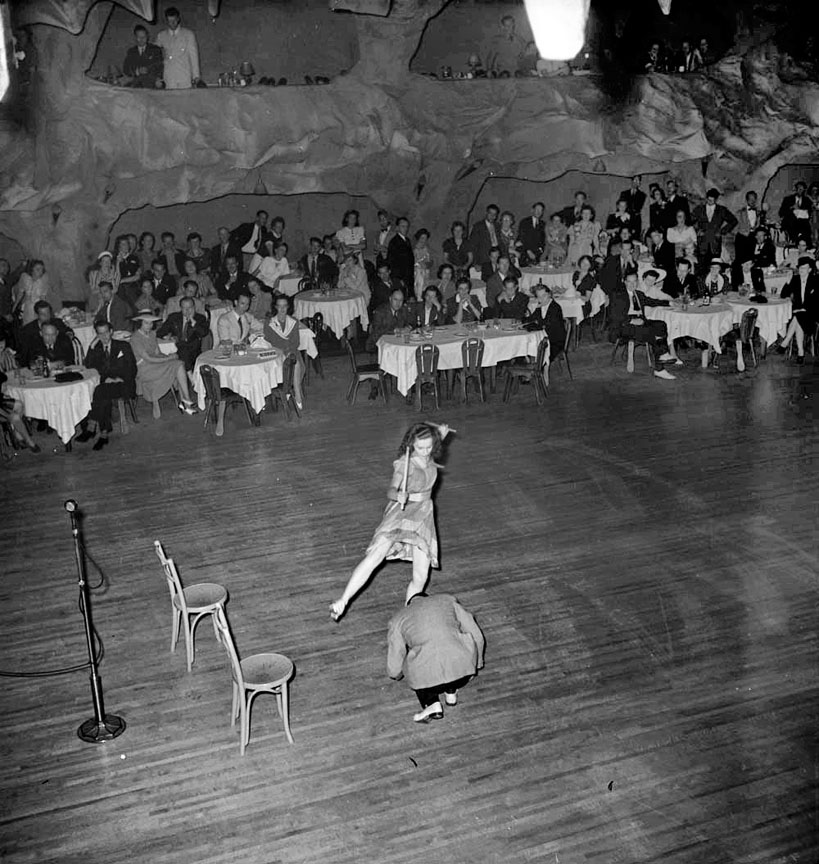
The Cave was decorated with stalactites fashioned out of burlap and plaster, and the walls were made similarly cave-like.
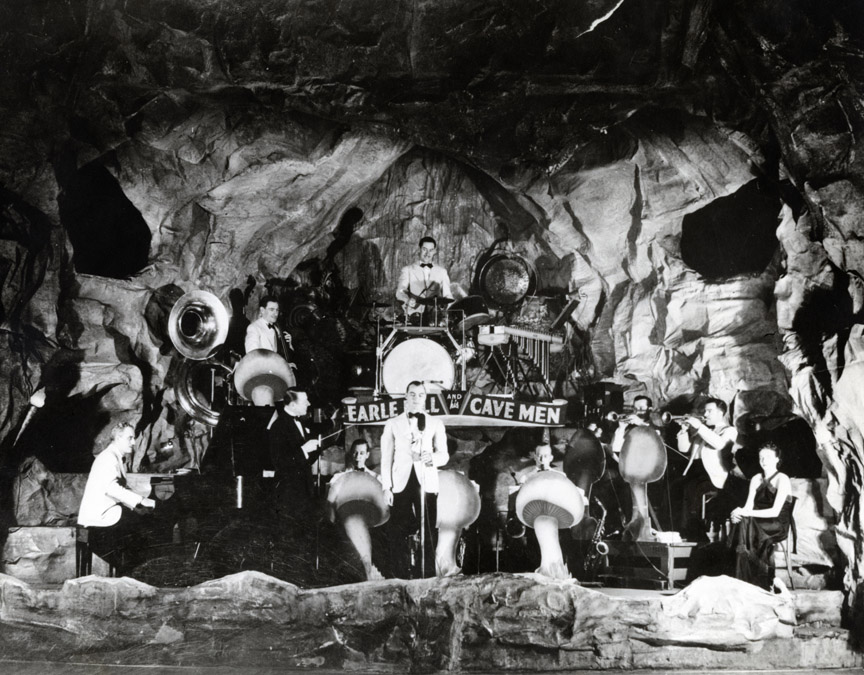
Earle Hill and his Cavemen. In the early days, it was a supper club with floorshows and an orchestra. Are those huge mushrooms? This is what I call a stage.
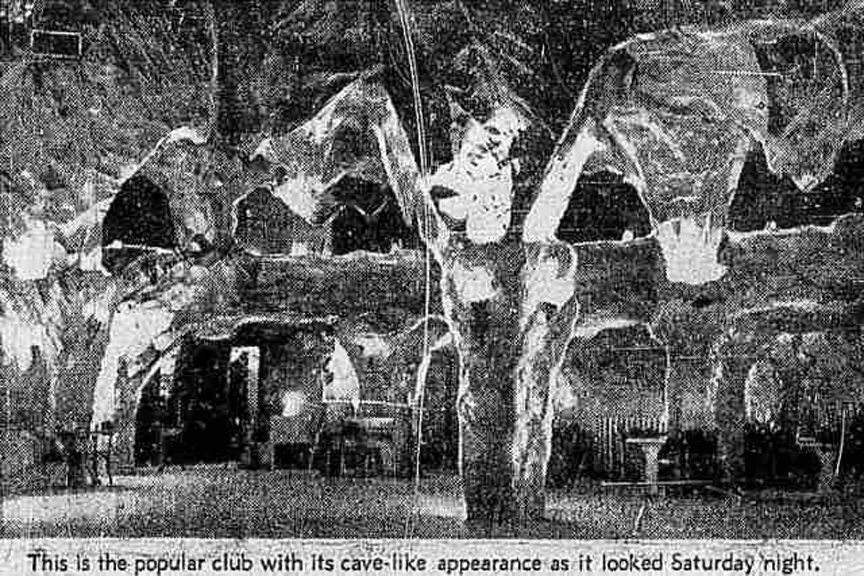
Other Cave Delights and Inspiration
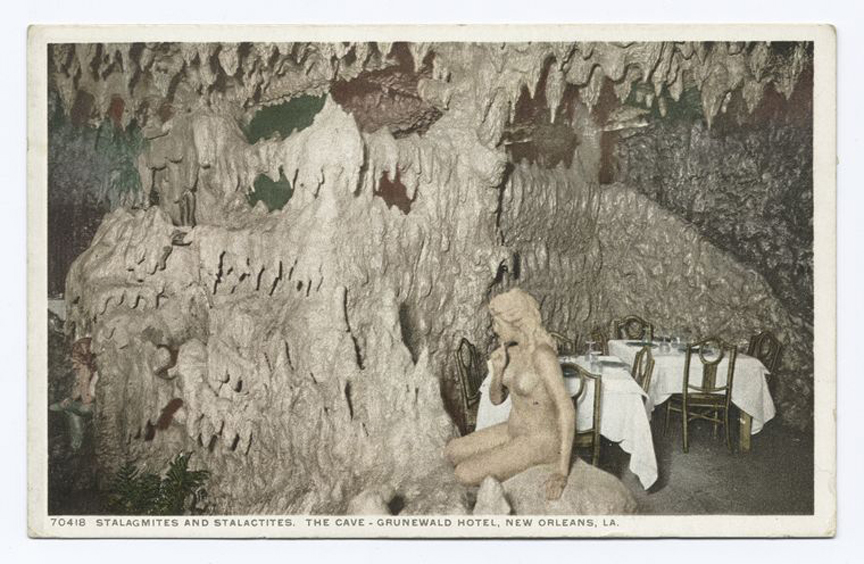
Cave nymph statue in the Grunewald Cave of the Grunewald Hotel in Louisiana. Lovely postcard.
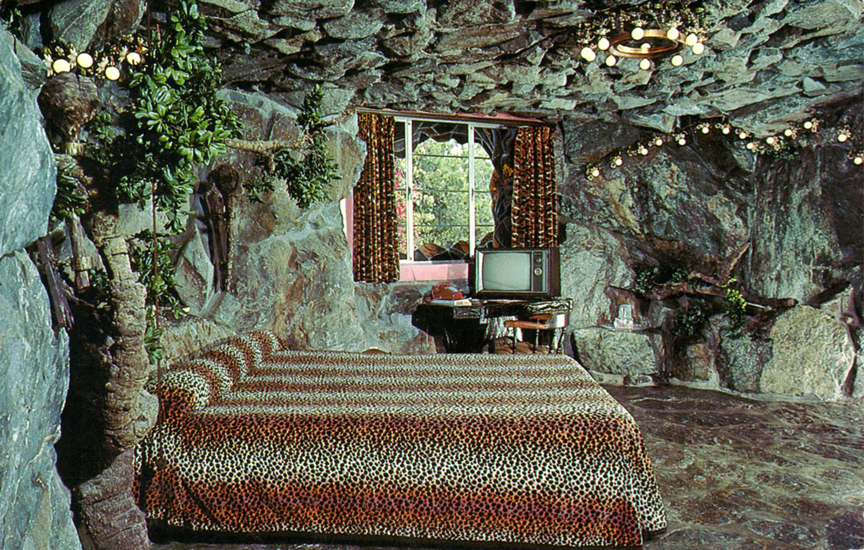
The Madonna Hotel room 137 in San Luis Obispo, California. Great postcard. Much later, of course, but would you get a look at that?
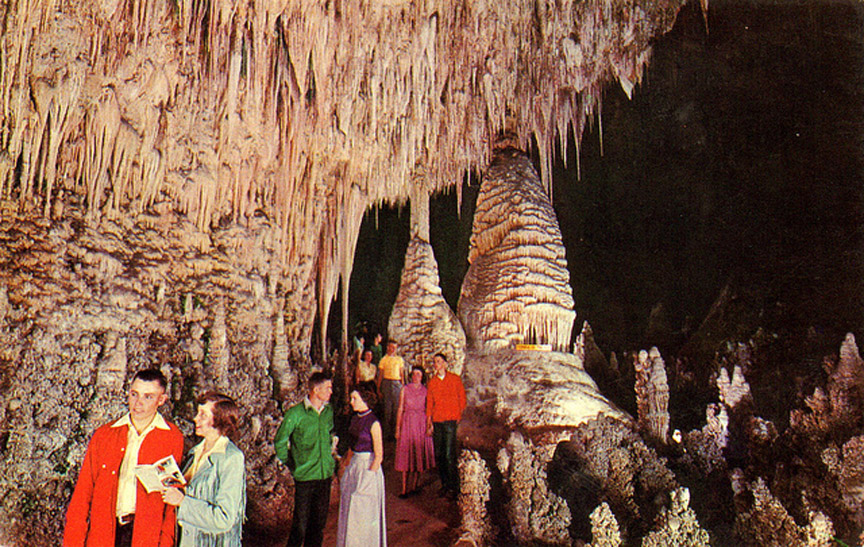
1950s, early 1960s cave tour. A favorite post card of a fantasy land.
1940s at the Cave Under the Hill
You know how I like to wonder off…well let’s get back on track. In 1940 all clues point to the Cave Under the Hill having expanded due to popularity. Look at this risqué caveman ad which I believe set the new tone.

January 12, 1940. “New Beauty New Comfort.”
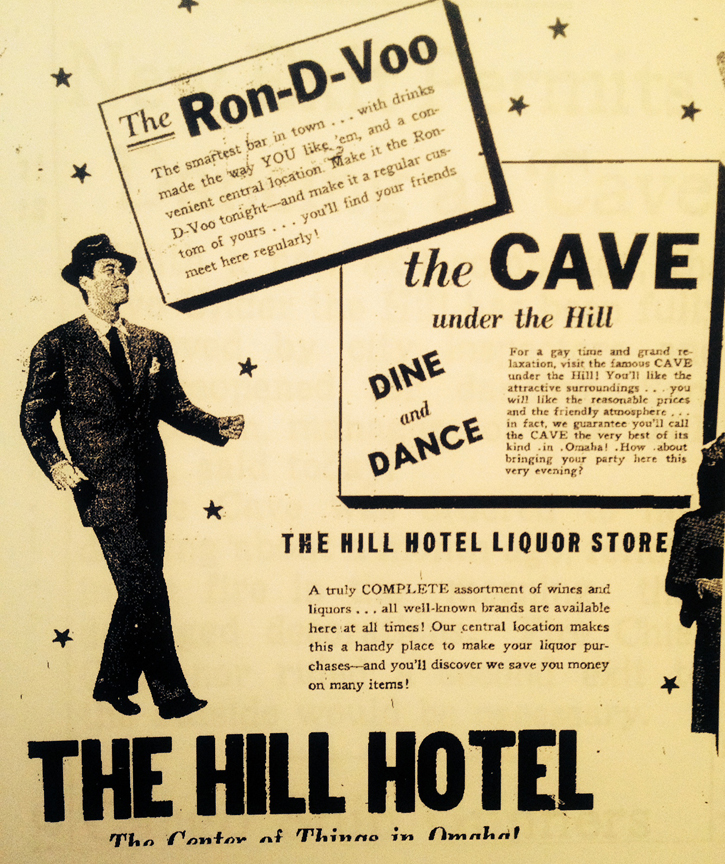
Also inthe 1940s the Hill Hotel began advertising for their newest bar, the Ron-D-Voo. The Hill Ron-D-Voo was on the first floor and had windows on both the Howard and Sixteenth Street side. The Ron-D-Voo was located in the bay that the Silver Hammer Surveillance is in now. Bands also played this bar nightly. Does it look like this man is displaying the overbite while dancing? I thought so too.
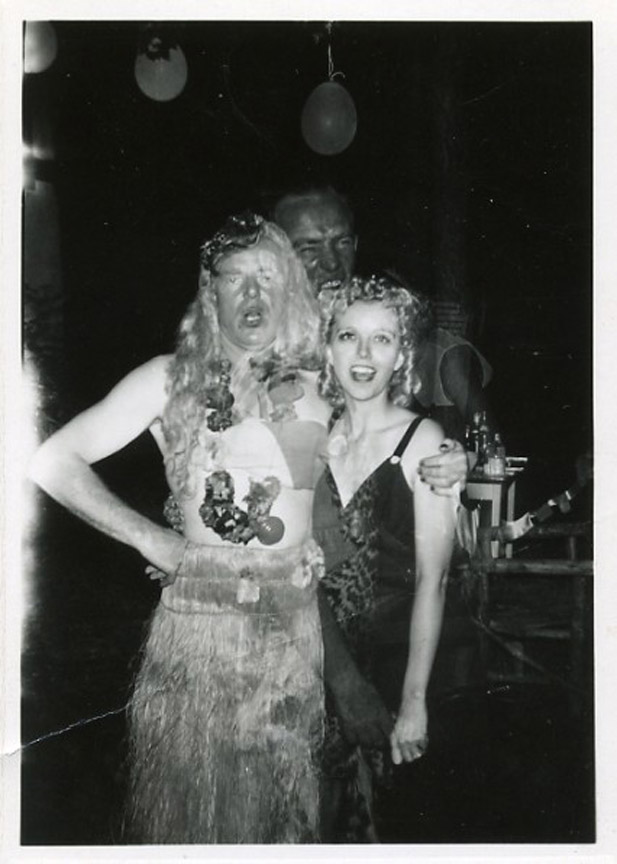
I love double exposures and this one is truly top drawer. Party time from this period.

Deb Lyons and His Cubs featuring Marie Dupree, “the Glamour Girl” played steadily from 1939 through the early 40s. Also popular at the Cave Under the Hill in the 1940s were the Four Esquires and Don Decker and his “fashions in song.” The Cavaliers, George Devron, Sid Pritikin as well as open Amateur Nights were big hits.
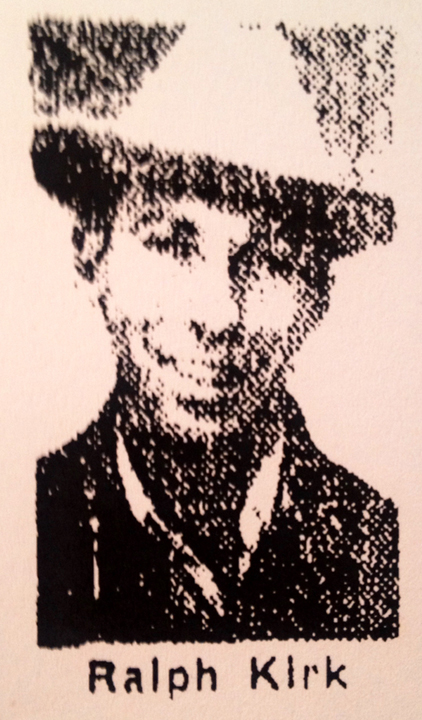
Ralph Kirk. I am just going to say it. He is so cute. He looks like an early 60s jazz musician. There was another popular act in town during the 1940s—Queenie, the trained cow with her trainer, Ralph Kirk, a rodeo clown. I only wish I had a photo of Queenie. Can you imagine what their show entailed?
Cave Under the Hill Gains an Entrance
In early March of 1943 the Cave Under the Hill started fire one Saturday morning due to faulty wiring in the Cave’s ceiling. The Fire Commissioner issues a no-dancing order at the Cave until “a new exit to the street has been completed.” The Cave was closed until later that April.
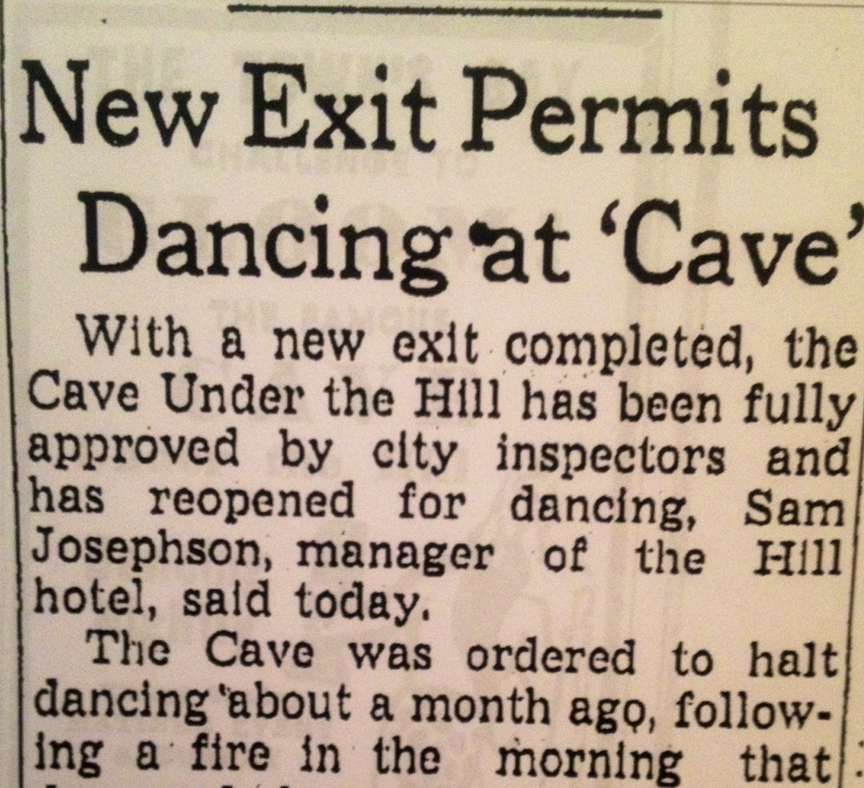
Omaha World Herald. April 21, 1943 “New Exit Permits Dancing at Cave” article. This unfortunate event led to the Cave gaining its very own entrance on Sixteenth Street, right next to the official front doors of the Hill Hotel. There will be photos of this entrance later in the article.
More Music
In 1944 Billboard Magazine gave the Cave a nod when listed in their Music Year Book under their Small Bands and Cocktail Attractions. It was so fun to read the names of these haunts state by state. Here’s the totality of the Nebraska list. Lincoln: Cornhusker Hotel and Lincoln Hotel. Omaha: Beachcomber’s Night Club, Blackstone Hotel, Cave-Under-the-Hill, Hill Hotel and Stork Club.
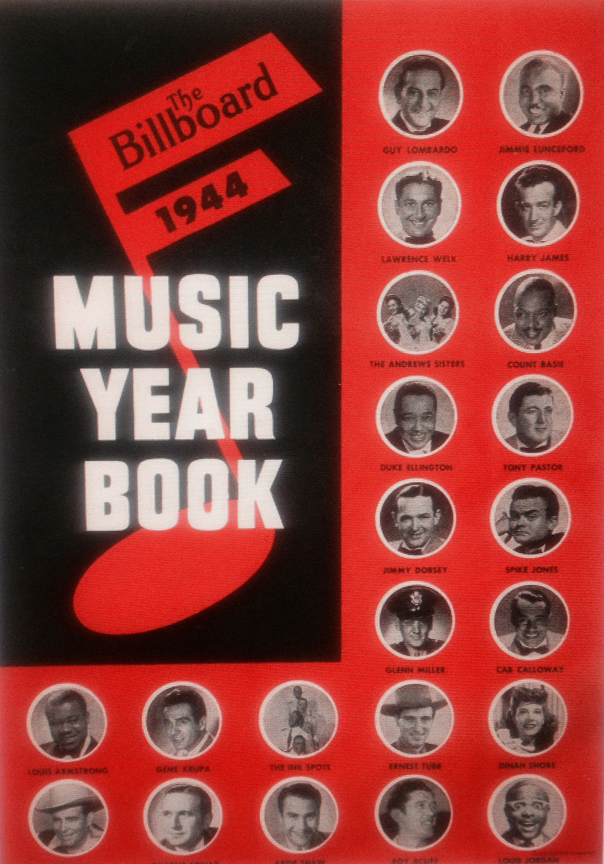
1944 Billboard Music Year Book
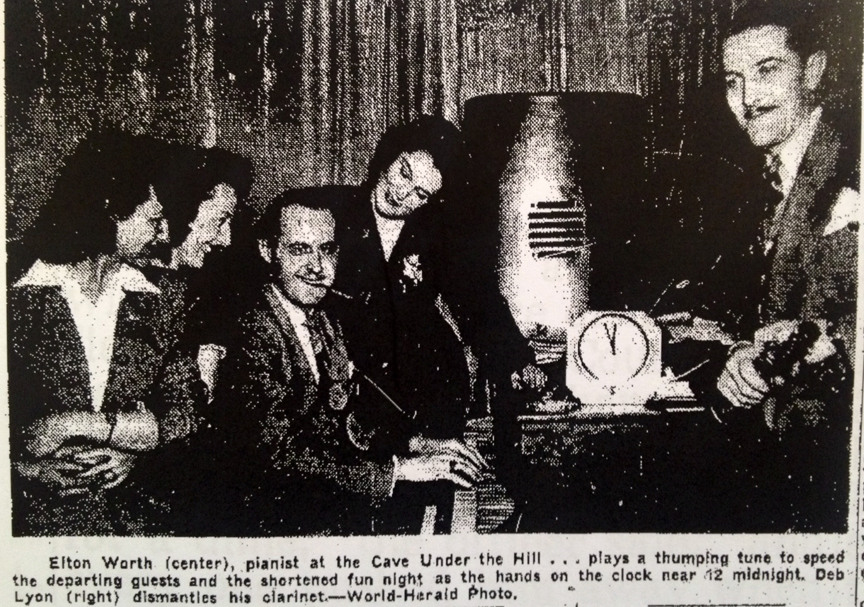
1945 Elton Worth, pianist at the Cave Under the Hill. This is such a great photo. “As the hands on the clock near 12 midnight.”
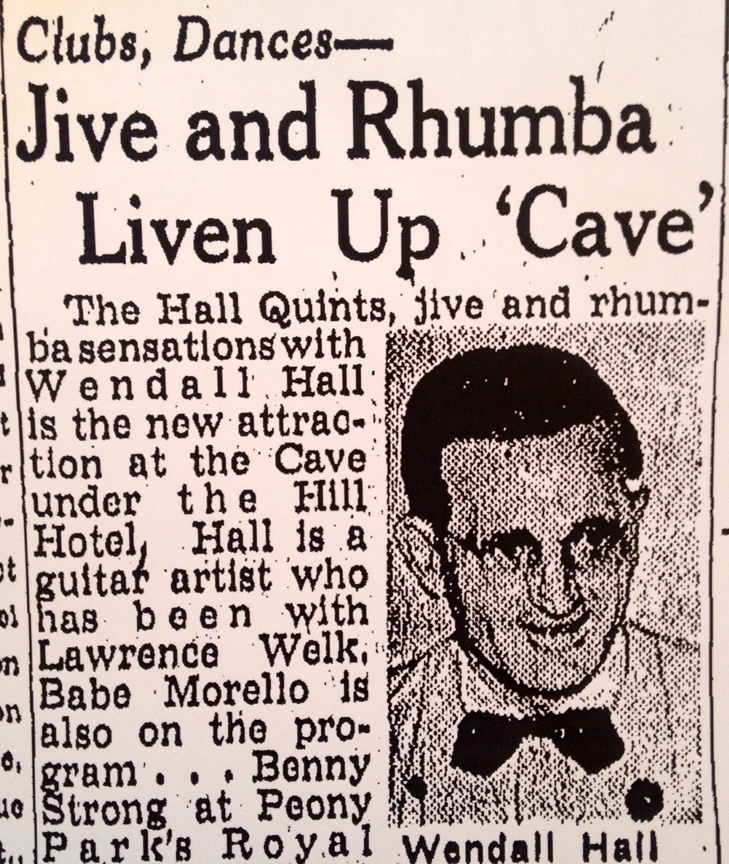
The Hall Quints led by Wendall Hall brought jive and rhumba to the Cave. They played for several years at the Cave Under the Hill under Hall’s lead. Hall was known for playing a console steel guitar that he had designed and built himself, the first of four steel guitars he would make. Hall had infamously played with the Lawrence Welk Band in the 1920s and 1930s. Yes, that Lawrence Welk. I located one fantastic article interviewing Wendall Hall. Hall reported to have just come back to the Cave bandstand after a break and “found two men shooting pictures of my instrument and taking measurements. I found out they were from the Gibson Company (maker of stringed instruments). About eight months later Gibson came out with a console steel guitar that was a copy of mine.” Holy smokes.
The Cave Under the Hill Gets Classy

Magnificent photo of an Omaha streetcar from the 40s-very early 50s. Corner of Sixteenth and Howard, looking south. Women are seen in front of the Hill Hotel on the left. Hotel Rome is seen further down the street. Aquila Court Building is across. Hotel Castle is on the west side of Sixteenth. One can see from this photo that Sixteenth was quite dense all the way past Leavenworth Street. Photo from the incredible book Omaha Streetcars Revisited by Richard Orr.
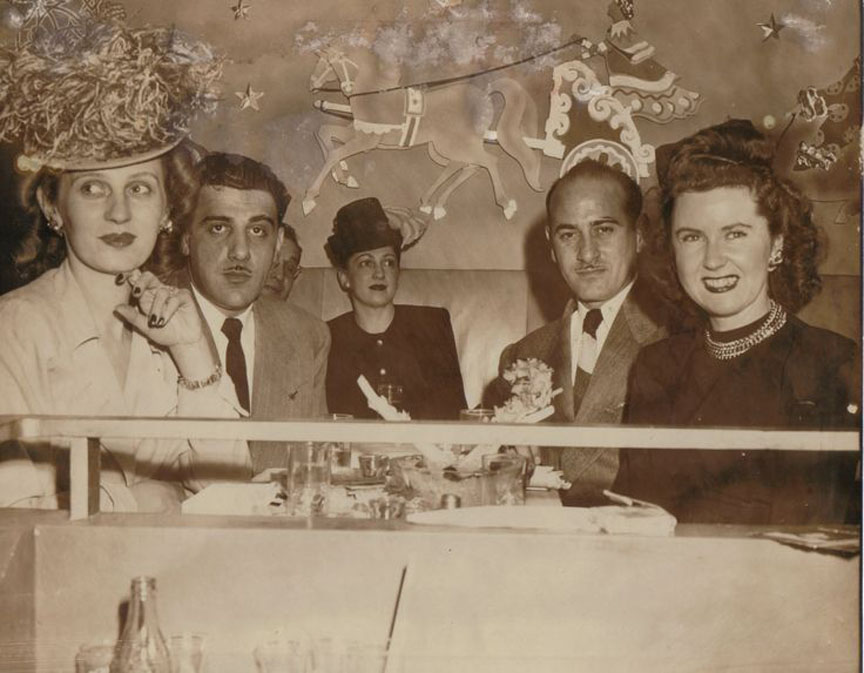
Omahan Michael Anania’s book The Red Menace, described his 1950s Omaha upbringing. Anania wrote of eavesdropping on his parents and their friends, in the shadow of World War II, “Listening to them on Sunday evenings made it seem like a great round of dancing nights at the Cave Under the Hill, dance bands at the Paxton Hotel or the Fontenelle, parties at the Trocadero and the Colony Club.” The importance of dancing and socializing in those postwar years cannot be downplayed. A great hint at the Cave Under the Hill’s folklore was an interview with Ken Boxley from the paper. Boxley was in a U. S. Navy officer-training program during World War II where his glimmer of hope was the rare weekend pass “to visit the Cave Under the Hill lounge in Omaha.”

1949-1950 edition of Hotel Hill advertisement. I love this time period when marketing really hit the polish. Sam Josephson was quoted as saying he wanted to make the Cave Under the Hill a “top fun center” which included putting in a much larger floorshow.

Chuck McDaniel with an orchestra at the Cave Under the Hill. Notice the stalactites and the treatment on the ceiling as well as the whole new feel of the Cave. Not exactly a Bilbo Baggins situation anymore. John Savage collection owned by the OWH, lent with permission by the Durham Museum. (Photo courtesy of the Bostwick-Frohardt/KM3TV Photography Collection at The Durham Museum Photo Archive).

Paula Lombardo was Big at the Hill. Lombardo was described as “Gorgeous Paula Lombardo. Dynamic Singing Star of Stage and Radio.” John Savage collection owned by the OWH, lent with permission by the Durham Museum. (Photo courtesy of the Bostwick-Frohardt/KM3TV Photography Collection at The Durham Museum Photo Archive).
Cave Under the Hill in the 1950s
Evidence points to the Cave Under the Hill intending to make the 1950s Bigger and Better. “Everybody Goes to the Air Conditioned Cave!” read the advertisements of the time. Under Josephson’s management the clientele in the 50s dressed to the nines under the new policy: the Cave was to be opened Sundays and there would be dancing and full entertainment every night. I dream of 50s jazz, the real thing. Was “Salt Peanuts!” ever exclaimed from the stage? Things I need to know.
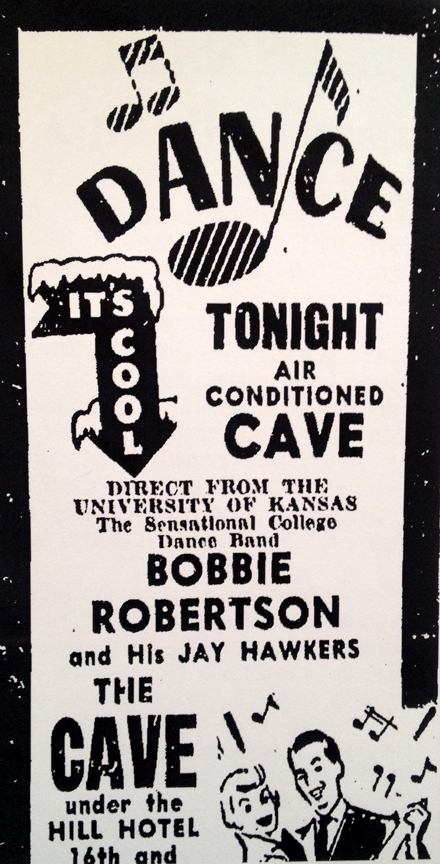
The Cave wasn’t just cool to adults. In 1951 the Hill Hotel faced a 21- day liquor license suspension for selling beer to a minor in the Cave Under the Hill. Josephson’s attorney called this unjustly drastic at a loss of about fifteen thousand dollars to the hotel. His belief was that only the Cave Under the Hill should have their license suspended, not the whole hotel. By the various ads I found looking for cocktail waitresses, a Mr. Dixon was running the Cave Under the Hill in the early 1950s.
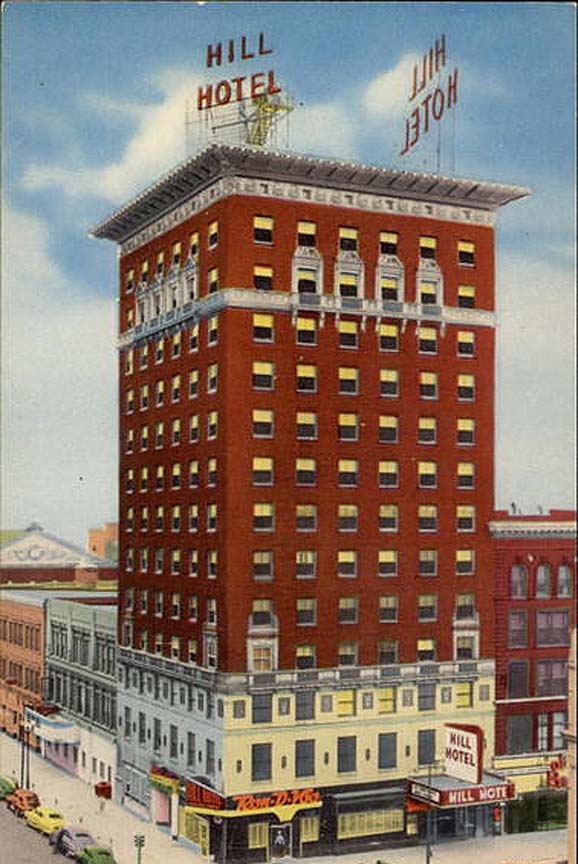
The best 1940s-1950s Hill Hotel postcard shows the Jack & Jill Coffee Shop on the north side. Ron-D-Voo entrance on the west. Great Hill Hotel marquee and Cave door just obscured to the south.
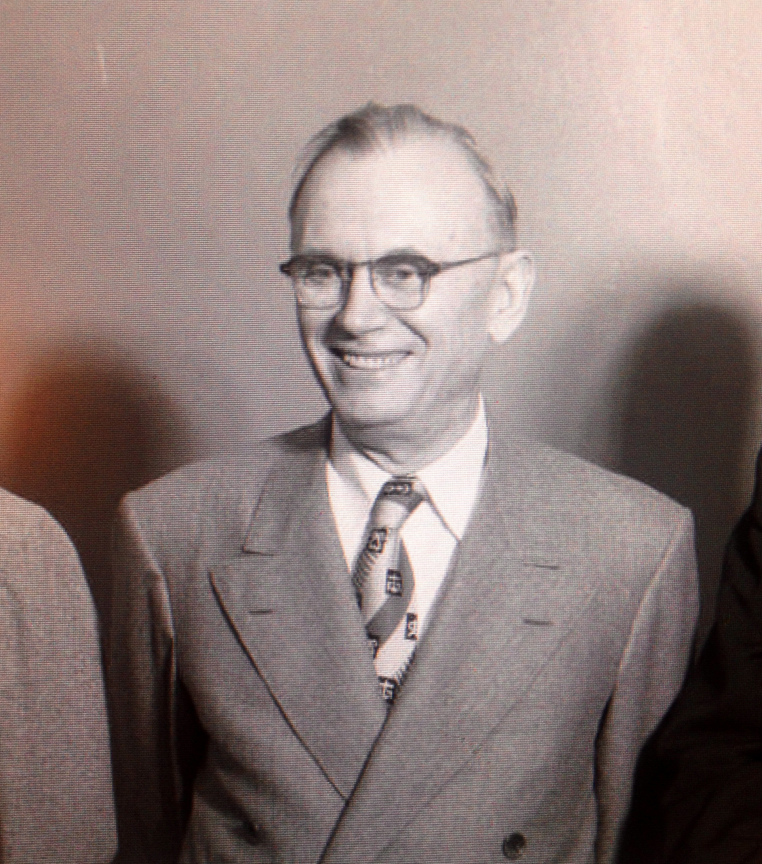
Mr. Samuel Josephson continued to manage the Hill Hotel. I found him featured in this photo from 1953. (Photo courtesy of the Bostwick-Frohardt/KM3TV Photography Collection at The Durham Museum Photo Archive).
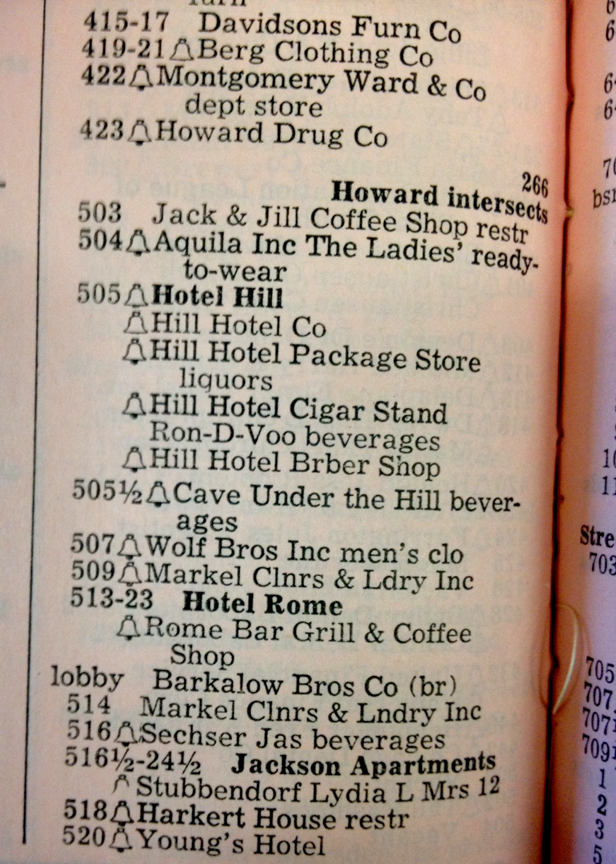
Omaha City Directory of 1954 shows the businesses involved in the Hill Hotel as well as the other ventures down the block.
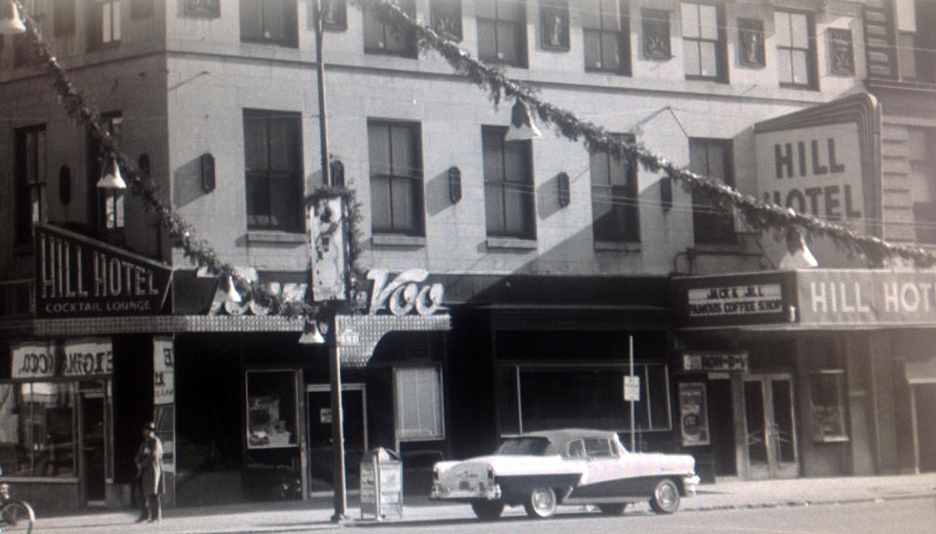
Mid fifties photo of a Mercury in front of the Ron-D-Voo. Thanks to good friend Syd Reinarz for his help in estimating the time period and for his love of cars. This photo adds a nice description to the above postcard.
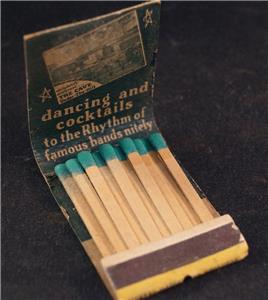
Divine Cave Under the Hill matches (found on Ebay) promised “dancing and cocktails to the Rhythm of famous bands nitely.”
The Cave Under the Hill Mysteriously Closes and Re-Opens
I dug and I dug and I dug but I could not unearth the date of the closing of the Cave Under the Hill. I am also not altogether sure why they closed. Much later in my investigation would I find that G & G Investment Company took ownership of the Hill Hotel back at the end of 1957. That would explain the closing and reopening of the Cave under new management. Originally the only breadcrumbs I came across were the remnants of its reopening in the form of ads for new staff.
February 1958: “MANAGER. We’re reopening the Cave Under the Hill and we will be needing a capable man by March 1 to assume its management either as an assistant manager of the hotel or as a manager-bartender.” And this from February 18, 1958 “Neat, attractive young lady with pleasing personality for the check room of the Cave Under the Hill. Opening soon. Evening hours. No Sundays. Apply to Manager. HILL HOTEL.”
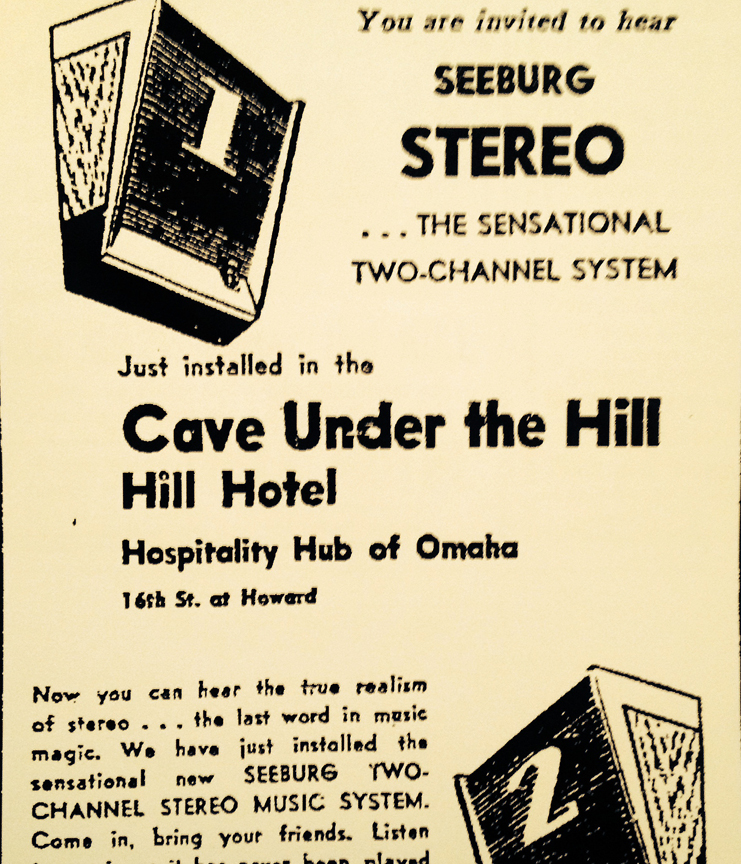
In March of 1959, the Cave Under the Hill had installed The Sensational Two-Channel Seeburg Stereo System. Boasting of the True Realism of Stereo. I had to investigate further. This was very cutting edge, as it turns out.
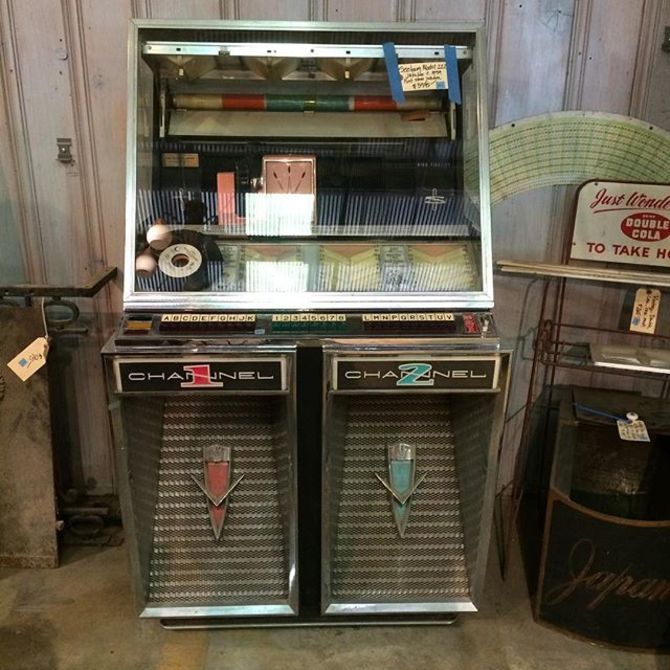
1959 famous two channel Seeburg Jukebox Stereo Model 222. The phonographs used the old Pickering “Red-head” stereo cartridge.
The Cave Under the Hill was changing its tune and the Seeburg Stereo speakers weren’t the only difference. I found ads for the Flairs.
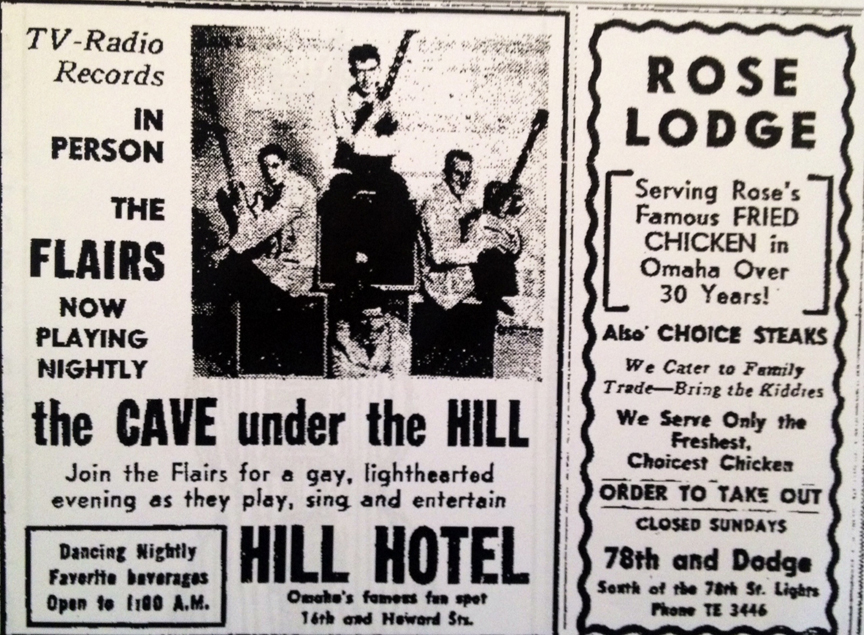
In Person: the Flairs. May 5, 1960. Also the comedy and antics of the Chuck Sutton Trio. This case was starting to look Rock ‘n Roll! Look at how they held those guitars. what sort of invasion was taking over the Cave? (Also take note of that tasty Rose Lodge ad. I have been working on that investigation for four months.)
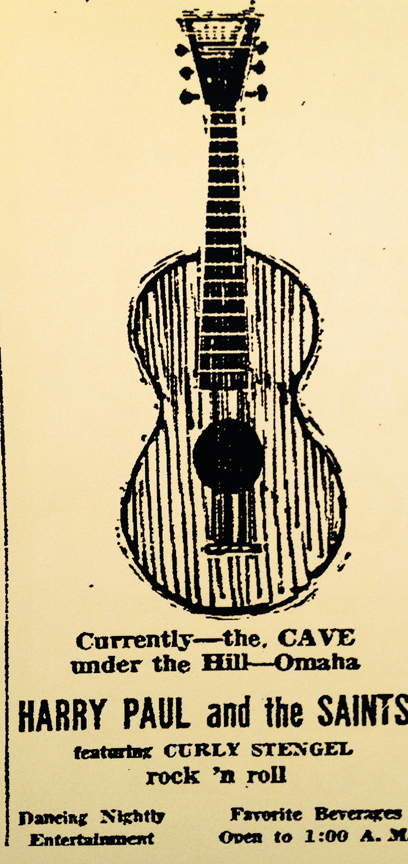
But the biggest trace was this 1961 ad for Harry Paul and the Saints featuring Curly Stengel “Rock ‘n Roll.” Rock ‘n Roll! It wouldn’t be long until I discovered the Cave was reinvented for another set of music lovers.
The Peppermint Cave Comes Alive!
I surmise that Don Hammond took the club manager’s job in 1958 when the Cave re-opened. I do not have proof of that, only that I knew he was confirmed manager in the later years. The theme of the Cave changed shortly after the hiring in 1958, leading me to believe that Hammond was involved. Don Hammond was a well- known Omaha club manager, having successfully guided the Seven Seas, among others from what I gathered. In his obituary of February 1996, Hammond was said to have operated the Peppermint Cave and many hotels and clubs in town. A tastemaker, Hammond just seemed to understand what the kids liked.
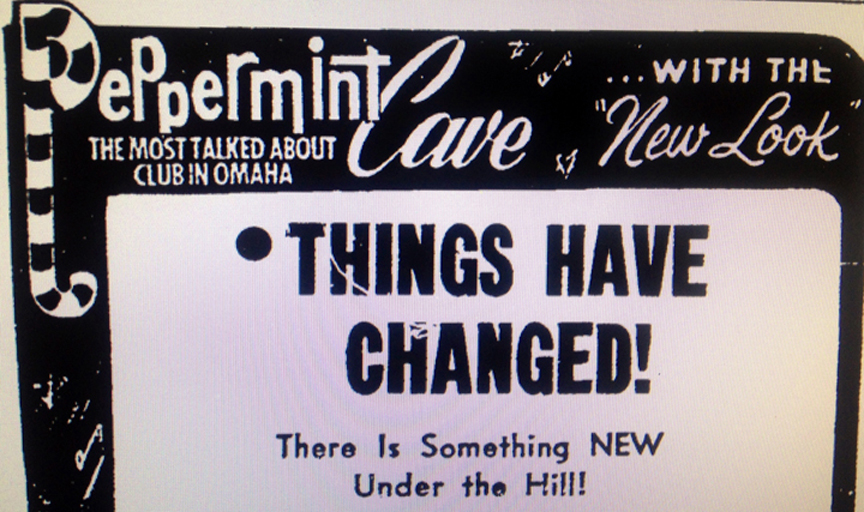
New Peppermint Cave revealed in February of 1962. I wonder what the “New Look” was?
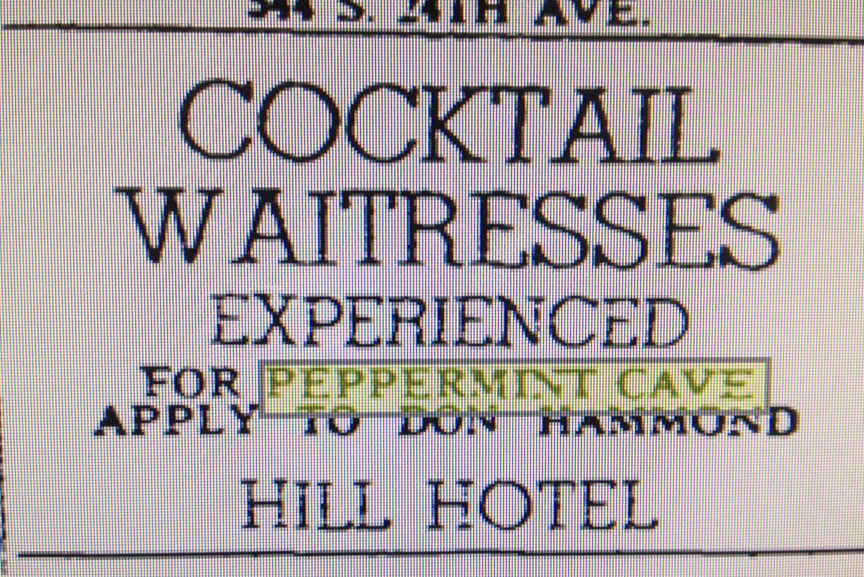
My first indication that Don Hammond was operating the Peppermint Cave was this cocktail waitress ad from 1962. I later found a lead from 1964: “Dancers Wanted—Girls for chorus line. Will train if interested. Must be 21 or over. Steady employment. See Mr. Hammond.” I am not sure exactly what all this line of work entailed but my father has assured me that girls dancing in a nightclub did not always mean what it means today. And for the record, I think Hammond meant go go girls, not really a chorus line but that was probably a more proper advertisement for the day. I could be inferring to much. The Peppermint Cave might have had a chorus line for all I know.

Early 1960s cocktail waitress.
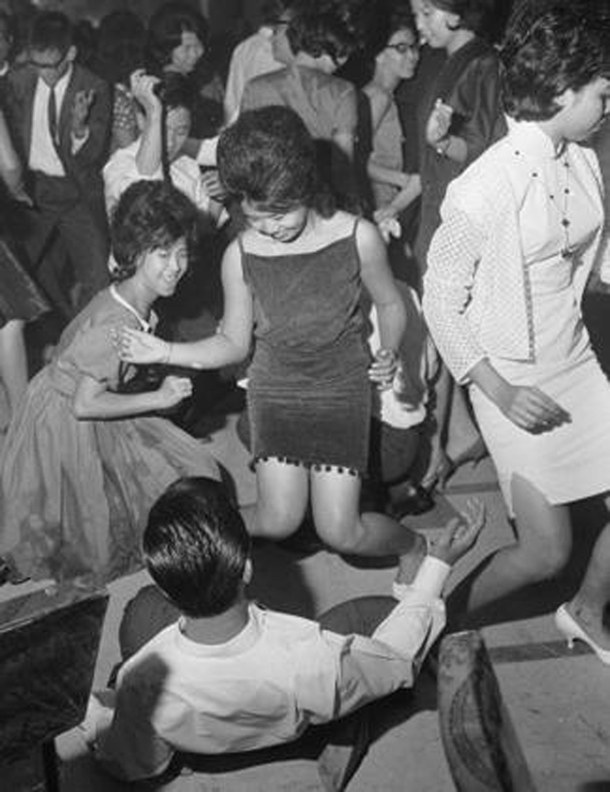
June 21, 1962: From The Rumor Department column in the Omaha World Herald: “They say business at the Peppermint Cave have fallen off since the Denver baseball team came to town. Twist addicts are in the grandstand getting pointers from Lou Skizas in the batter’s box.” Later in 1962 there was a bust at the Peppermint Cave for serving to a minor.
**Addendum of 6/7/2017** This just in from Father of Miss Cassette:
“As I remember it, the Cave (Under the Hill) was named the Peppermint Cave when ‘The Twist’ came out (Chubby Checker’s big hit at the time and latest dance craze). For a short time I dated one of the girls who was a dancer (on either side of the musical group’s stage.) The two dancers were in round(?) cages with colored vertical bars with stripes to look like peppermint sticks. I think that’s accurate but my memory is fuzzed up. Her name was —- —–, was cute, short, had short platinum hair in a bouffant and was quite a good dancer. She was madly in love with John Lennon and whenever she came over to the apartment I played all my Beatles music. Another big plus in my favor was that I had painted a good likeness of John. The bar on the first floor of the Hill was full of gay men who sat around the piano bar and had a lot going on in the rooms above in the hotel. Across the street was where the lesbians had their own bar. The gay males and females mixed and were friendly. They didn’t stay in their own bars. I went upstairs to the Hill’s bar to buy a bottle of Jack Daniels and had my hands behind my back, and someone tickled the inside of my hand. I jerked it back in front of my and turned around – I thought some guy had done it but it was a waitress who thought my reaction was hilarious. In my perception, the Cave was for heterosexuals and gay people weren’t encouraged to go as couples to The Cave because it might turn off the young heteros who spent a lot of money on the whole latest rage dancing The Twist.”
Bands of the Peppermint Cave
The Hot Spots for bands to play in the early 60s were at Mickey’s A-Go-Go and the Peppermint Cave. The Rogues, The Esquires, The Eccentrics were very popular. I’m sure there were more bands and I hope to hear from readers who went to these shows back in the day. Sadly I could not find any videos from the Peppermint Cave but I was able to find these out-of-hand, amazing videos from this time period in Omaha.
https://www.youtube.com/watch?v=NTuR2QPIabE
Check out the Rogues, performing “Anything You Say.”
https://www.youtube.com/watch?v=LJMyi_5htzE
Another band from this Peppermint Cave time period was the Wonders. This is their hit single, “I’m Not Willin.’”
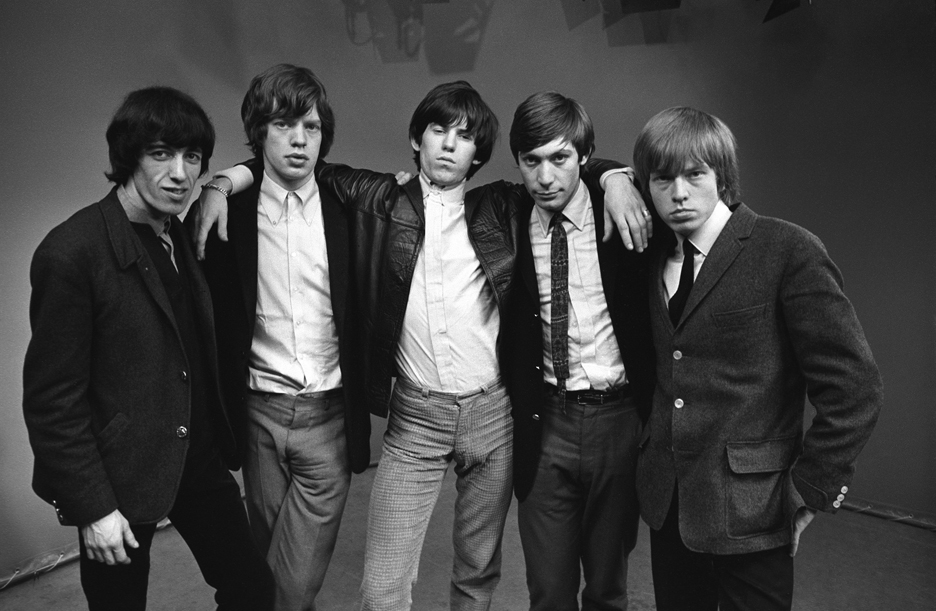
The Rolling Stones from 1964.
According to an Omaha World Herald article, David Trupp, of the Eccentrics, was a twenty-one year old when he met the Rolling Stones in June of 1964. David was drummer of the band, the Eccentrics. The owner of the club (I am assuming Don Hammond) apparently asked Trupp and his band if they would “Hang out with an English rock group that’s in town, show them around before their concert at the Civic (Auditorium).” Can you imagine? Apparently the Rolling Stones never got that grand Omaha tour, instead the two bands “Hung out in the hotel room at the old Indian Hills Inn near 84th and West Dodge Road” for a couple of hours. The fantastic but brief article mentions that Trupp spent most of the visit talking music with Brian Jones, who would die only five years later. Everyone who knows me, understands that I about fainted when I discovered this.

Eccentrics band photo from 1964. Too Cool.
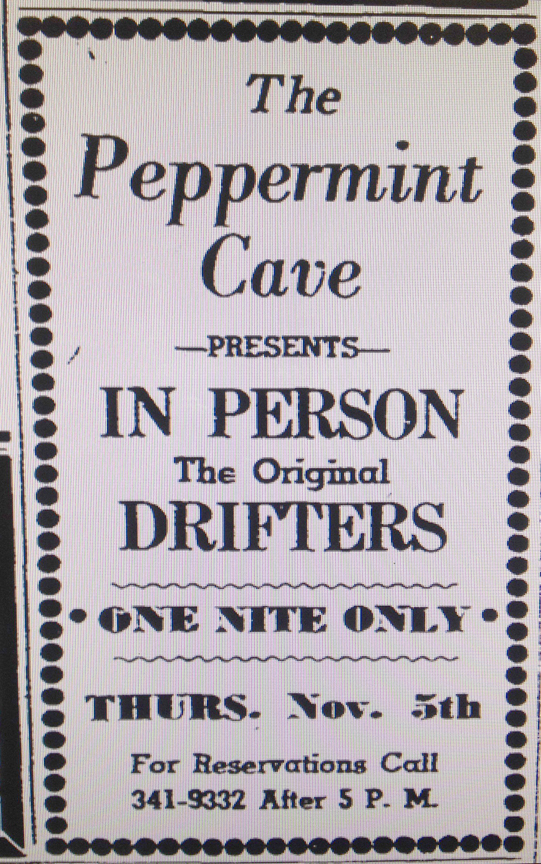
November 2, 1964: The Peppermint Cave presents the Drifters. A new addition: calling for reservations. As if that wasn’t enough, there was indication that in October of 1964: “Native dancer, Andre, from Tahiti, is the special attraction this week at the Peppermint Cave. The Fabulous Esquires, three guitars and drums, provide the music.” Now that must have been something to see.
Here is an amazing video of people dancing in 1964 at the Whisky A Go Go. This gives an excellent feel for the time.
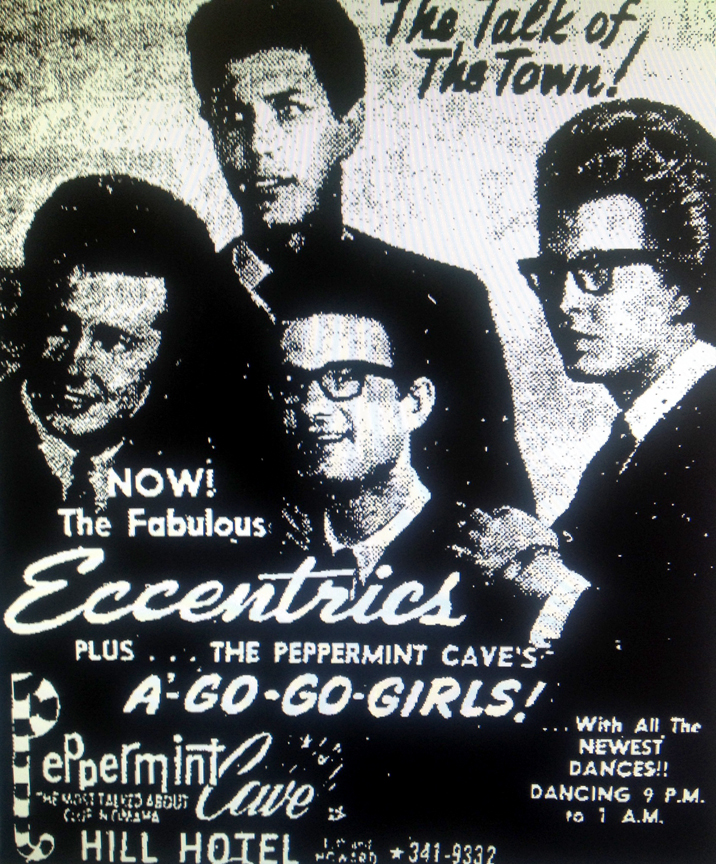
The Eccentrics ad from August of 1965. The name, the look…just perfect.
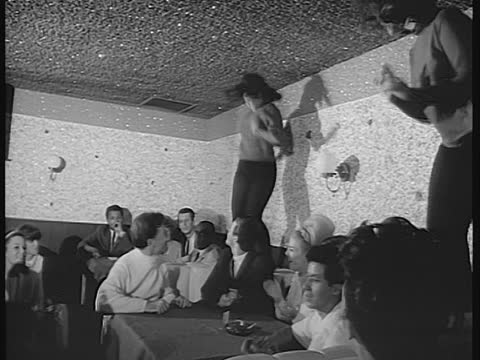
PHOTO: Go Go Dancers from 1965. This is a great example of a basement club from the period and the look of go go dancers that my father has described. The Peppermint Cave was mentioned in an OWH article from 1965: “On hand are two a-go-go dancers and the Green Dandys, the group that appears nightly at the Peppermint Cave.” The Green Dandys. Fab name.
A Pre-Conscious Space
All of this 1960s Omaha garage music, drinking, dancing and cave fetishism has reminded me of a brilliant time in Omaha not that long ago. If you were around for this spectacle, then you remember fondly Sean Ward’s Pre-Conscious Space. Check out Sean’s work at: http://www.seanrward.org/ A Bemis Center for Contemporary Arts architectural installation by artist Sean R. Ward, A Pre-Conscious Space or “The Cave,” as it was affectionately called, was a multi-functional art space built within the Okada sculpture facility, directly to the east of the Bemis Center. http://www.bemiscenter.org/art/past_section/cave_art.html Like something from the town of Bedrock, Ward created a cave environ, (premiered on July 24, 2009 during Mutual of Omaha’s Wild About Omaha celebration) which was supposed to continue on as an installation-venue for up to 18 months past the opening. The Bemis held a number of events there and it was the talk of the art and music community.
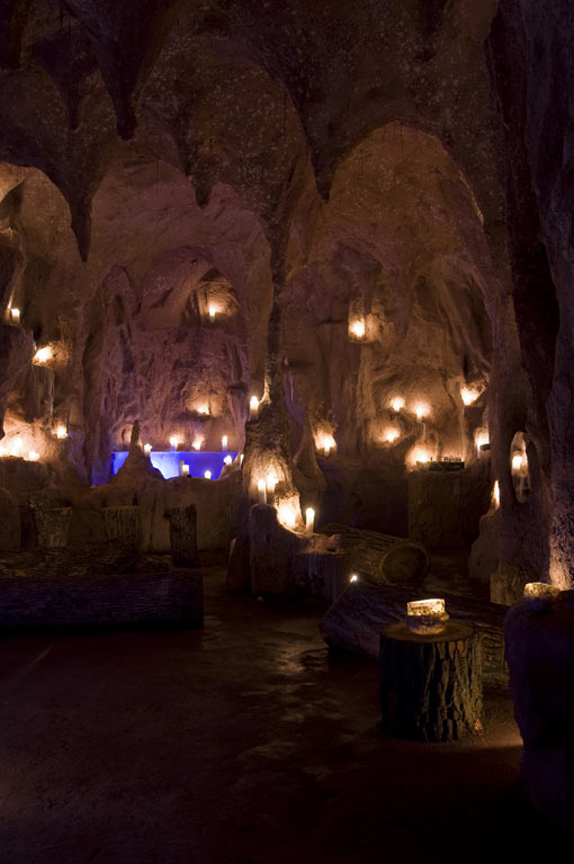
Words cannot describe the experience of having been in the cooling-warming glow of the Cave, listening to live music there and celebrating, as humans have done for years, in a contemporary Cave of our own. The Cave was nothing short of magical.

The acoustics were divine…there were no parallel surfaces in the Cave, creating a recording studio sound environment. Absolutely no echo—an enchanting, intimate feeling that I will never forget. Here is dear friend, Dereck Higgins performing on the glassy Cave stage. https://dereckhiggins.bandcamp.com/ Primordial memories.
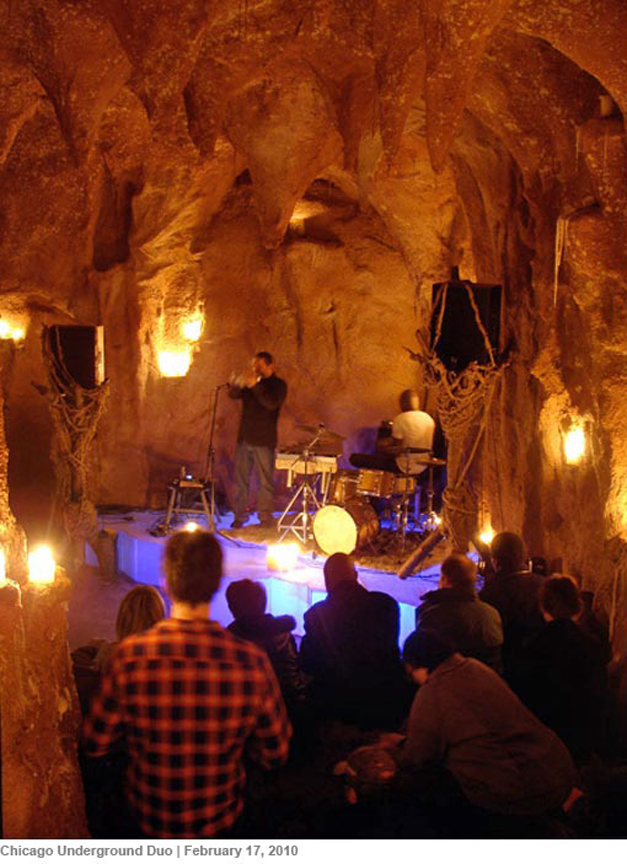
Mr. Cassette and I even contemplated getting married there. I was planning a garage music event there to mimic the Peppermint Cave days. Sadly it was mysteriously discontinued after roughly seven short months by the Bemis board of directors.
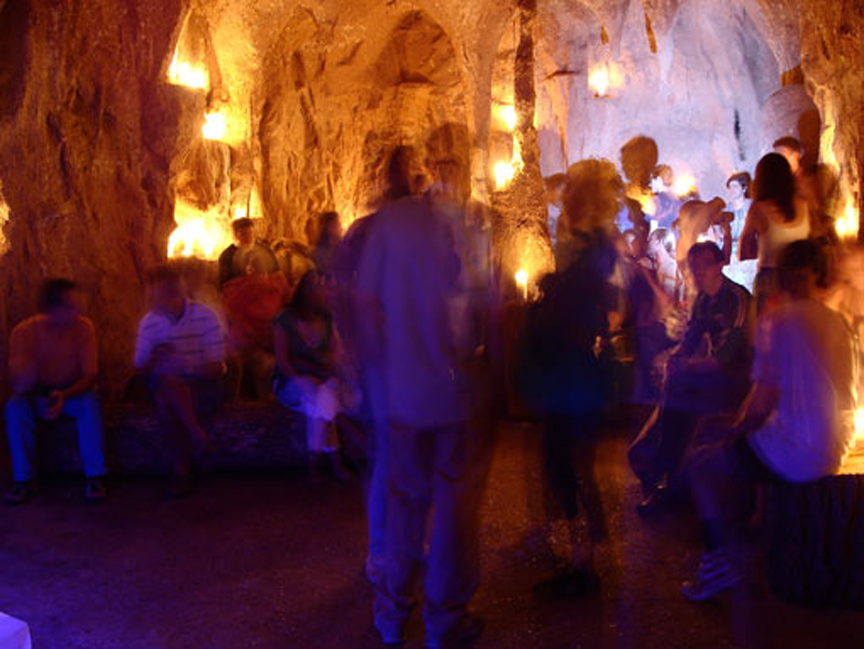
These photos barely touch the experience.
I was able to find this video of the Cave from 2009 by Gilda Snowden. I love her commentary.
The Peppermint Cave Becomes a Teen Club
An Omaha World Herald article of June 24, 1966 announced: “Don Hammond, manager of the former Peppermint Cave bar in Hill Hotel (it’ll reopen soon as a teenage night club) plans on opening a bar soon near Fifteenth and Howard Street. Don said he plans on decorating it ‘in a theme that will be compatible with Nebraska’s Centennial.’” I was surprised as the Peppermint Cave, by all accounts, had been quite the spot for the drinking aged crowd of music lovers. I began to wonder if the Vietnam War had anything to do with it, seeing as so many in this age group came from Omaha and western Iowa.
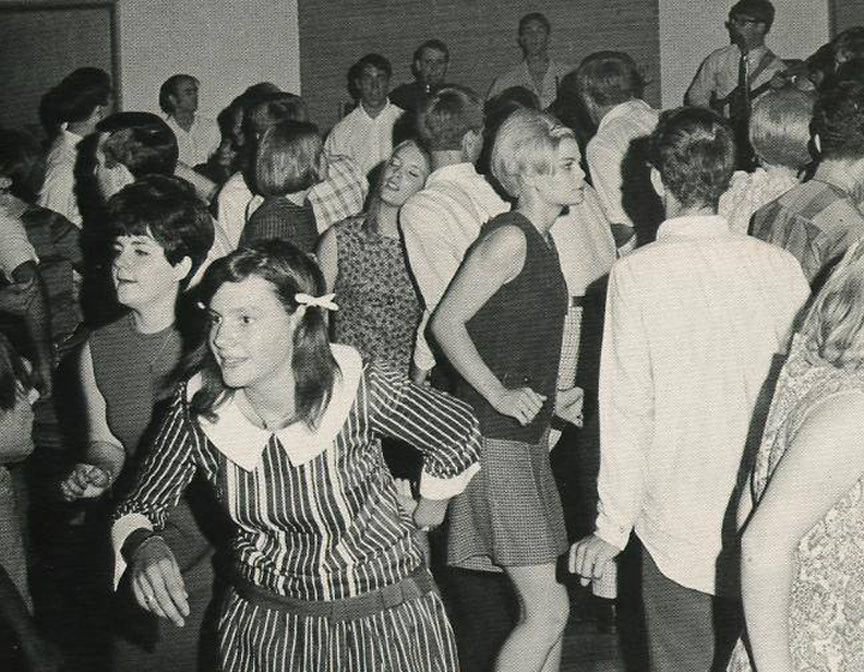
1967 Kids the Bugaloo. Not the Cave but appropriate in year and look.
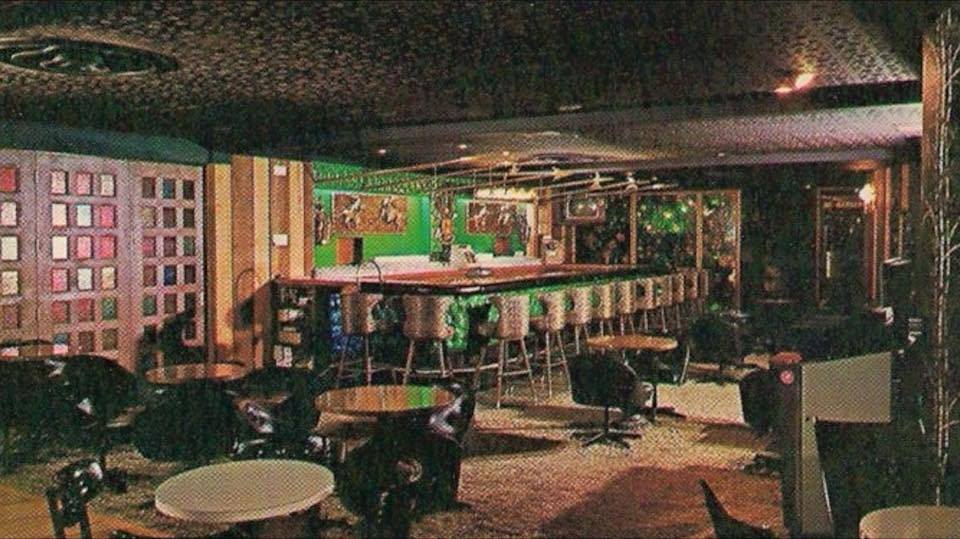
The Lazy Leopard Lounge 1960s. Terrific photo lent by good friend, Dave Roszelle. Omaha World Herald article of October 6, 1967 read: “Mr. Tyrell has been replaced at the New Tower by Don Hammond and Charles Roubicek. Mr. Hammond is handling the night shift operations of the New Tower’s Lazy Leopard and the Bird Cage Bar. Mr. Hammond, who also owns the Peppermint Cave Teenage Club in the Hill Hotel at Sixteenth and Howard plans to keep the club there.” I found out later that Hammond also owned the Wild Cherry too.
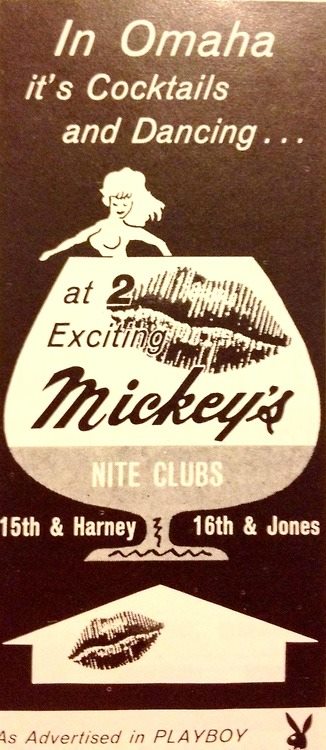
I located an interesting article from June of 1971, actually about strip clubs in Omaha. Mr. Sparano, who had owned a number of clubs in the day, talked about trying to class up Mickey’s after encouragement from his family. He had switched Mickey’s risque look to a quiet piano bar, “And I was the only one in there singing.” He was quoted as saying, “That was about the time the twist came in and the Peppermint Cave opened. I’d go over there and waiting in line, everybody would pat me on the back and say what a nice place I had now, but my customers were all over at the Peppermint Cave.” Meaning that no one in Omaha was too interested in Sparano’s cleaned up club. Sparano would go on to be the first club owner to introduce go-go girls. This advertisement for Mickey’s from the late 60s-early 70s was clear evidence that Sparano went back to his tried and true nite club method. Of course, Miss Cassette must investigate this in full at a later date.
The Peppermint Cave for Teens Fizzles Out
The 1973 Omaha City Directory was the last time that I would find the Peppermint Cave listed. I had no solid evidence to offer proof of the teen Peppermint Cave closing other than no longer finding it listed. Why did it close? I did find a number of great photos from the Hill Hotel of the 1970s, thanks to the generosity of Trina Westman at the Omaha City Planning Department.
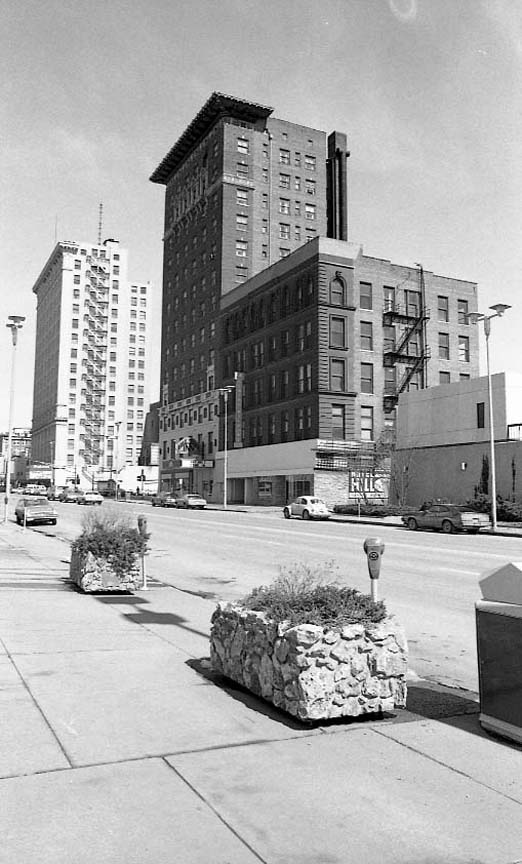
Facing north. This photo shows the old part of the Iler annex, still on the south side of the Hill Hotel. Photo from the Omaha City Planning Department.
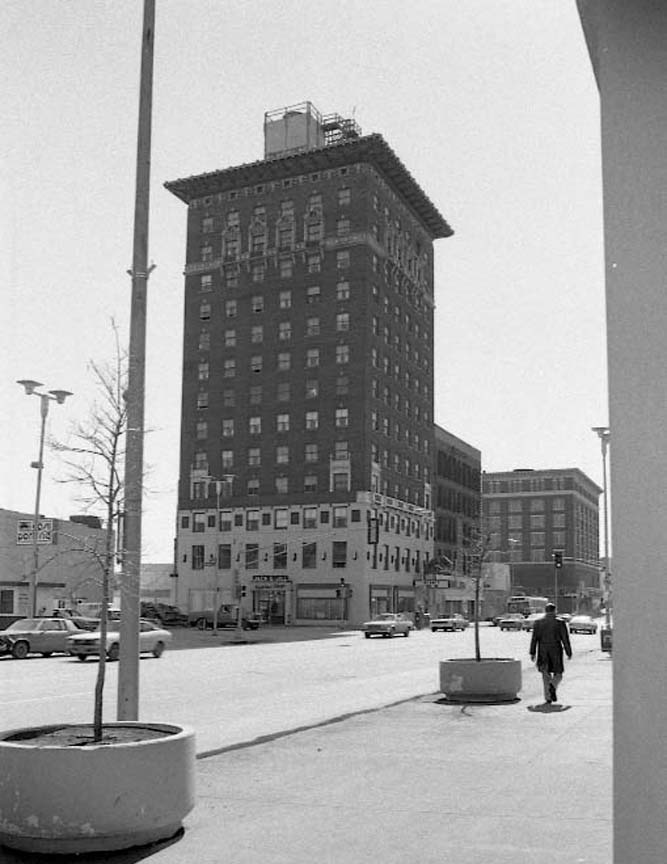
Photo facing south, shows the Jack & Jill Coffee shop in the middle bay. Photo from the Omaha City Planning Department.
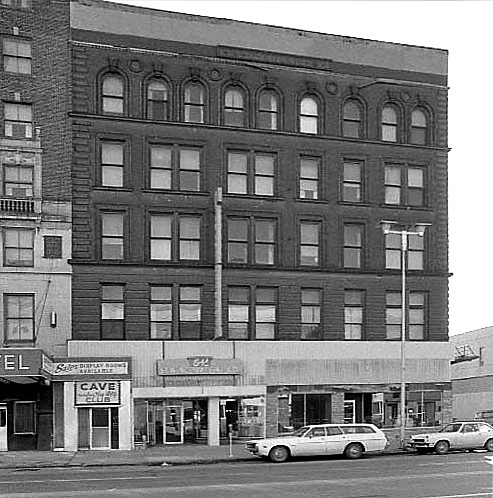
Fantastic contribution from Detective Steve Raglin. Thank you!
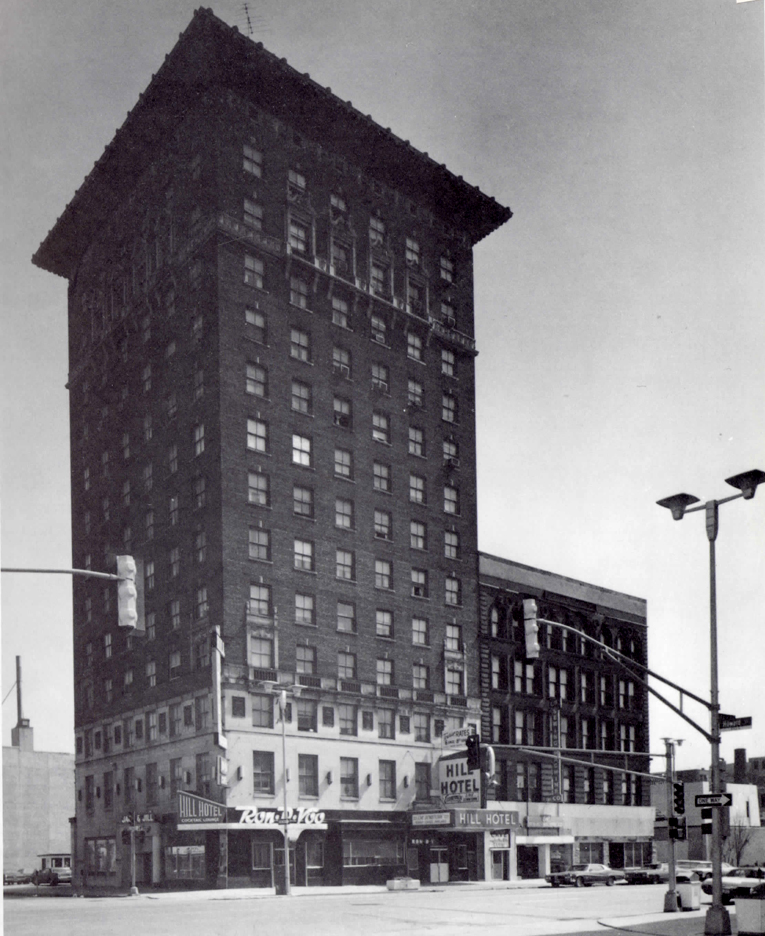
In 1977 Landmarks, Inc. and the Junior League of Omaha put out a fantastic book called Omaha City Architecture. The photograph above, by Lynn Meyer of the Omaha City Planning Department, shows the Cave sign still above the door. The book stated that the Hill is presently owned by the G &G Investment Company and “still in use.”
The Cave Club
As I had alluded to earlier, when I was much younger, a close friend had told me of fabulous gay club in the late 1970s. I knew it had “Cave” in the name but as to where it was and what it was, I had no idea. This friend has since passed away and so I was unable to ever put those pieces together. But I am pretty sure, beyond a shadow of a doubt, that the club he described was our little Cave.
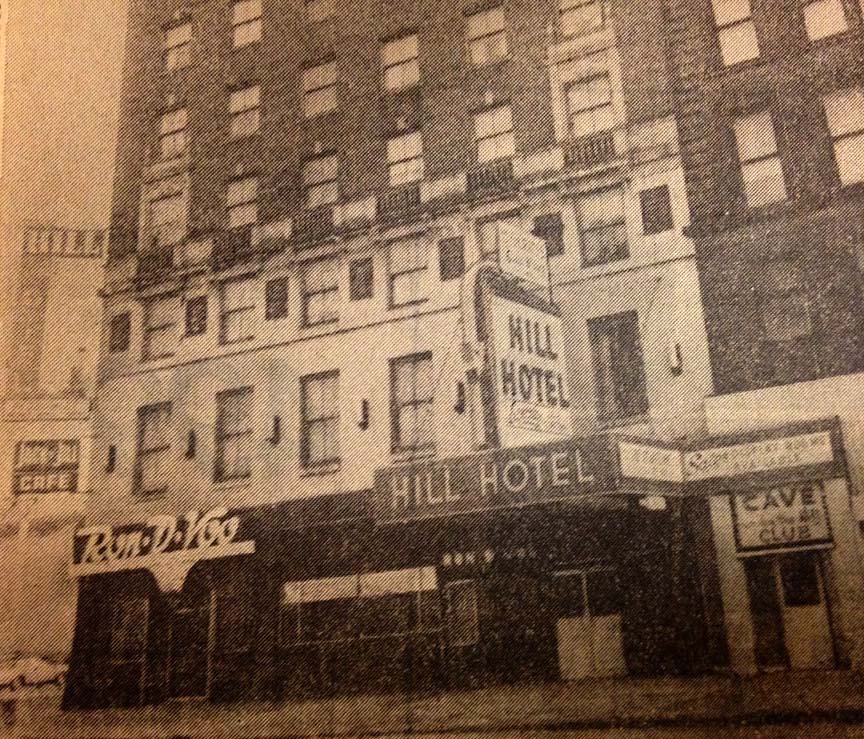
Finally an up close and personal view of that Cave street entrance. From OWH file clippings at the Omaha Public Library: November 30, 1978 “Hill to Become Second Hilton.” Note the Cave Under the Hill Cave sign. Above the Cave sign is another sign saying “Sales Display Rooms Available.”It wasn’t until I saw this photo and later did a search for old gay clubs in Omaha, did I find this gem of a site: https://omahagayhistory.wikispaces.com/Local+and+Regional+Gay+Bars
I will quote from this article, if you promise you will take the time to read this whole memoir on Omaha Gay History. It is the only glimpse into the real Cave Club during this period, as they surely were not covering this scene in the Omaha World Herald or in Omaha books. According to Omaha Gay History, the Cave Club flourished in the late 1970s through very early 1980s. “It was the most popular gay bar in Omaha. To enter the establishment, one descended a wide-open stairway down into the basement of the hotel, into a simple large room. A long bar was along one wall. Air-conditioning was poor… no doubt to increase beer sales. It was always said that the beer was watered down to increase profits. The favorite beer at that time was Schlitz. The ceilings were low and consisted of 12×12 inch dirty acoustic tiles of the day with multiple tiny holes to control the acoustics. The floors were simply dark asbestos tiles. A simple Formica-topped restaurant table served as the DJ booth with a single turntable for the music.”
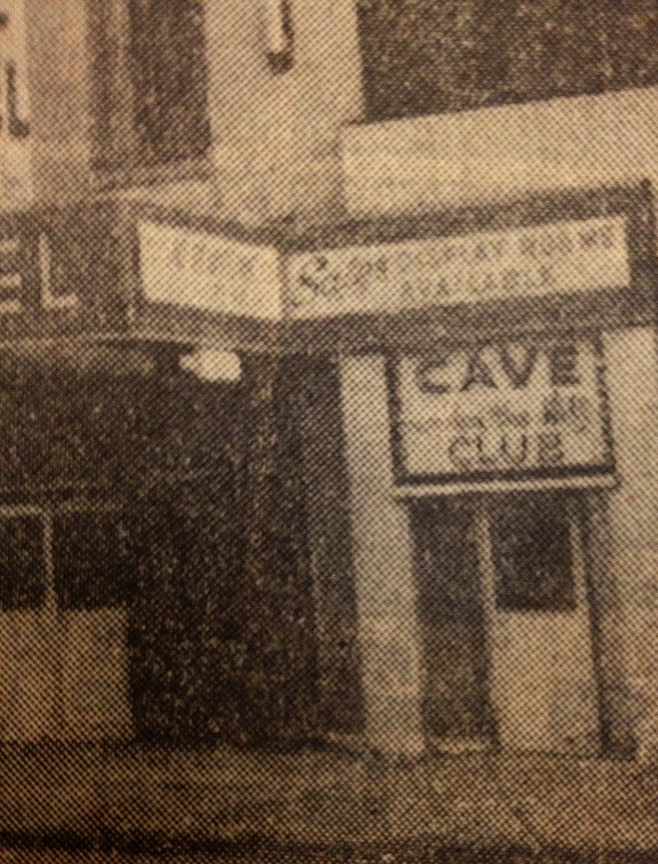
I guess I zeroed into this detail hoping I could see something extra or maybe enter the photo in some way. The writer of Omaha Gay History believed the Cave Club experienced some “violent activities including a stabbing I believe, which understandably kept away business. Also the violent activities caused problems with the establishment’s liquor license.” He estimated that the entrance was boarded up in the early 1980s. This detective did track a robbery at the Cave from 1977. The Bartender was held up for $50 but that was all I could unearth. What had happened to the Cave Club?
The Mysterious Cave Closing
The Omaha City Directory of 1979 still listed the Hill Hotel, The Cave and Ron-D-Voo. By 1980 the Hill Hotel was now called the Hill Town Inn (at 341-9332), if you like to make weird phone calls like me. The Ron-D-Voo Tavern was still present. I felt a little melancholy when I discovered for the first time there was no Cave listing at all. I need to know more.
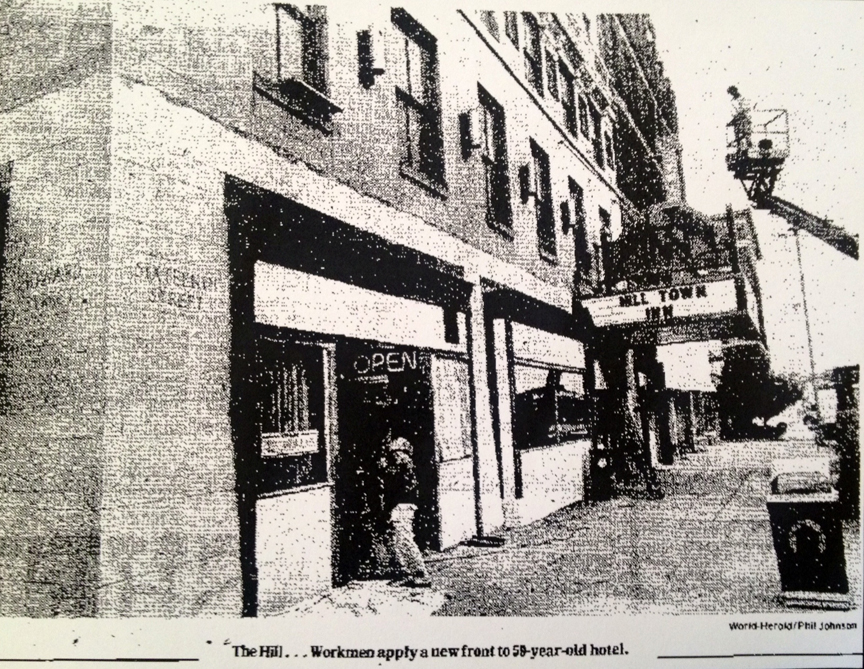
According to the Omaha World Herald article dated October 12, 1979, Fred Winkelmann bought the Hill Hotel in November of 1978 for $350,000. He renamed it the Hill Town Inn, renovated the whole building to include the façade. His ownership and restoration of the Aquila Court Building (now Magnolia Hotel) was thought to be a model of downtown restoration. He also had intention of renovating the Flat Iron Hotel. Well he certainly had good taste. More on Fred Winkelmann in my Hill Hotel story. Fascinating! Winkelmann had envisioned plans to turn the old Ron-D-Voo bar into the Hill Town Collectors’ Inn, a gathering place for stamp collectors. He wanted to replace “the now closed Jack & Jill restaurant and Cave Under the Hill basement bar” with a new restaurant and European-type nightspot. Oh my…
The Town Square Restaurant and Lounge
In August of 1980, Fred Winkelmann opened the Town Square Restaurant and Lounge, which occupied most of the main floor of the Hill Town. The Town Square was to be open seven days a week. The journalist wrote “the downstairs Cave Under the Hill is all gone.”
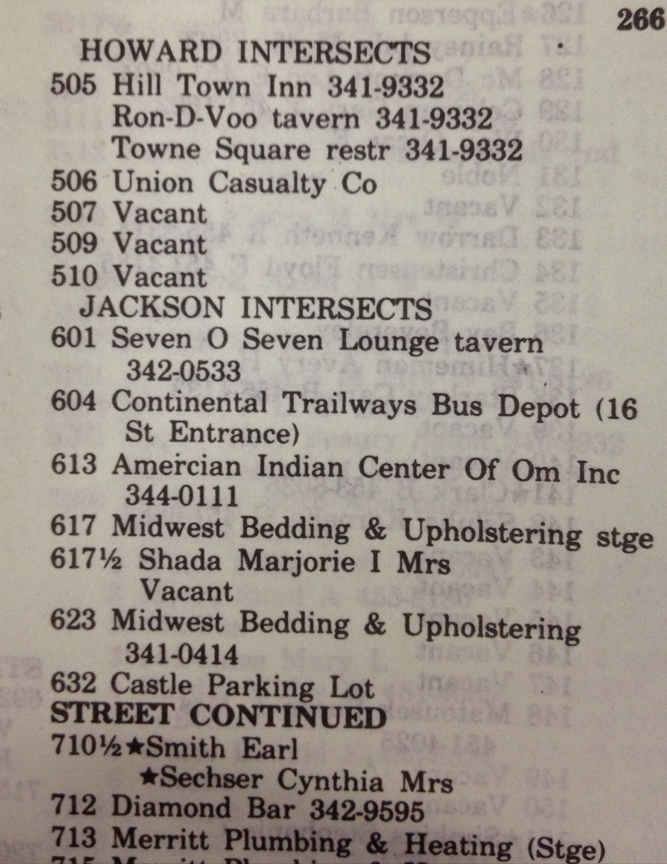
PHOTO of 1981 Omaha City Directory: Cave is now gone. Hill Town Inn, Ron-D-Voo, Towne Square Restaurant. Note the Diamond Bar was now at 712 S. 16th St, another historic Omaha gay club.
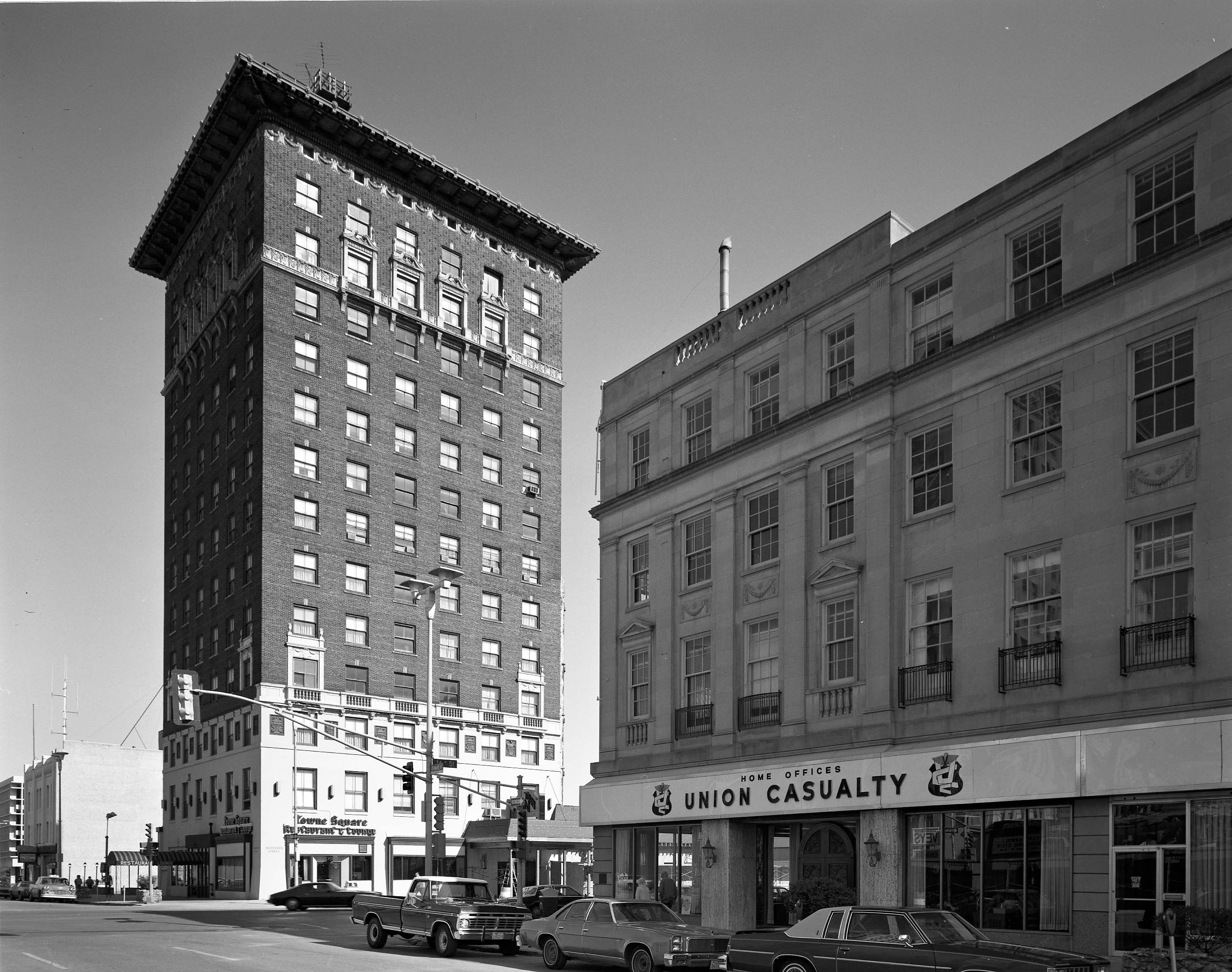
West façade looking southeast. Photo by Lyn Meyer. 1983. Omaha City Planning Department photo. Note the sign that says Towne Square and also the extended entry with awning on the north side of the building. Winkelmann must have taken out the old west Hill Hotel entrance and made an addition to the west side–perhaps the European bar?
Additional Mysteries Solved
From the “National Register of Historic Places Registration Form” filed in 1988, I learned what happened to the southern most wall of the Hill Hotel—the pinkish part that looks like a building has been taken out—as though she had omitted some essential article of clothing. Yes, why does it look it look that way?
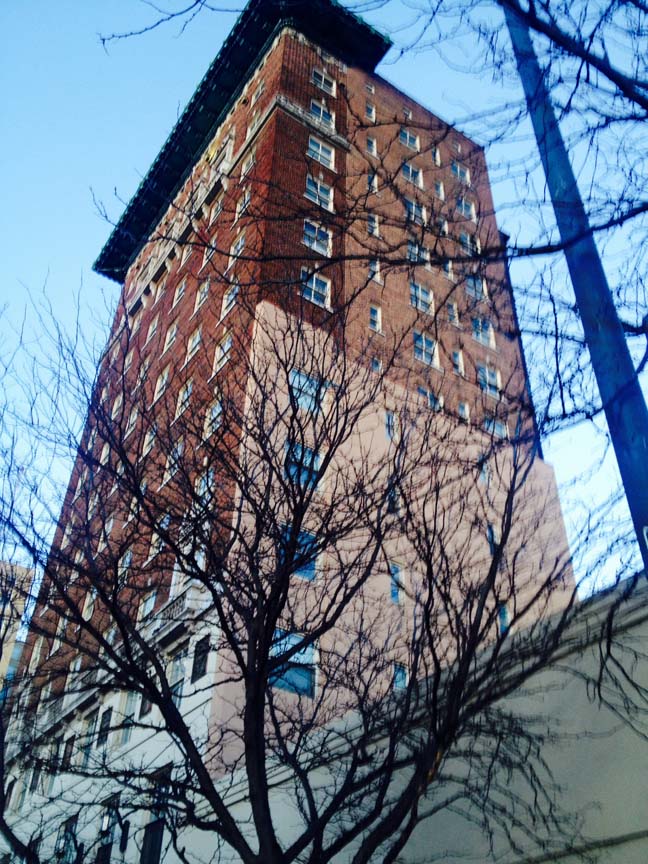
“On the south, the Hill was constructed to share a party wall with a five story masonry building, the Iler Block, which served as an annex to the hotel. In 1980, the Iler Block was reduced to one story and remodeled extensively both on the exterior and the interior; virtually none of the original building’s historical fabric remains. The parapet of the Iler building extended approximately up to the seventh floor level of the Hill. Below that area, wall openings have been bricked in, leaving the imprint of the earlier construction.”

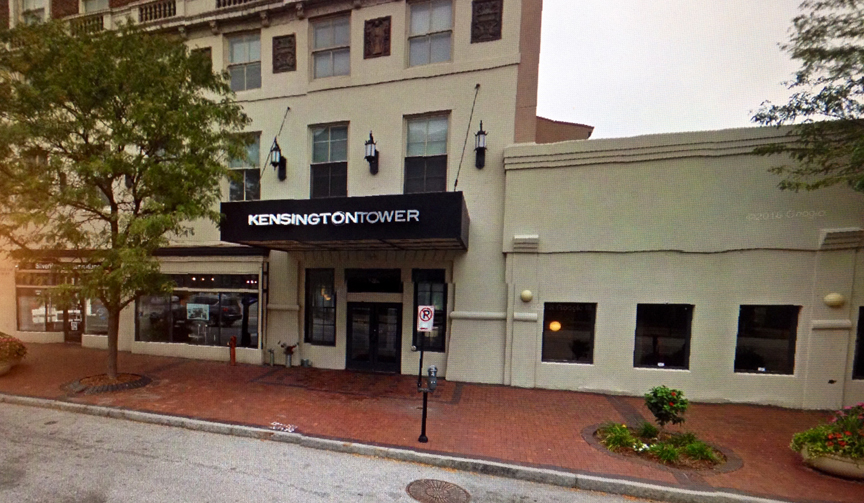
From these photos, one can see that the Cave Under the Hill was in the original bowels of the Grand Iler. I deduce that the Cave was where the original Grand Iler Baths and later the Hill Hotel Turkish Baths were. Any remnants of the Cave are most likely gone as virtually none of the original building remains. But I think we need to get in that basement to be sure. ***Update: according to fellow detective Kevin Tierney, although one would enter the door to right of the main door of the hotel, the club was under the Hill not to the right under the annex. He added “at the far end (probably under the Howard St Jack and Jill Space) was another staircase that was closed off at the top as far as I could tell.” So that blows my theory. I am now wondering if the Hill Hotel Turkish Baths were on the newer Hill side or on the Iler side. Mysteries abound!
Kensington Tower Apartments
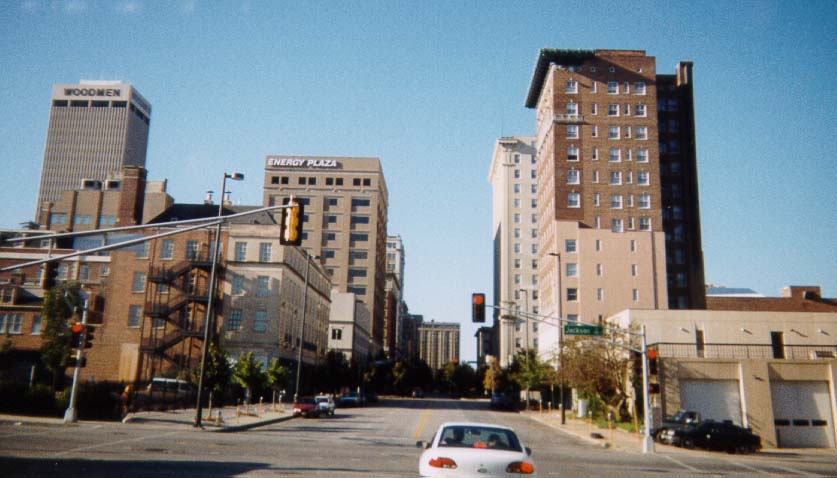
The Hill Hotel–Hill Towne Inn was converted into the Kensington Tower Apartments in 1994. My good friend, J.T. Phillips, took this photo at Sixteenth and Jackson, facing north, in 1996.

Oddly I took the same shot a couple of weeks ago.
The Cave Mystery Continues
There were so many specifics about the Cave Under the Hill, the Peppermint Cave, the teen Peppermint Cave and the Cave Club that I was not able to unravel. I do hope that some of my readers will come forward with some of these details.
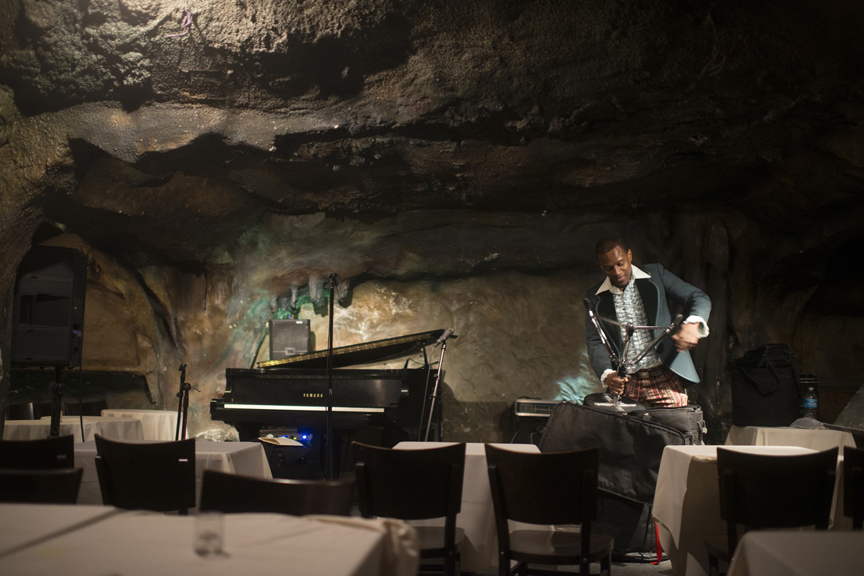
Why is it that these fabulous Cave Clubs have all died away? We must never forget that all these beautiful things cannot be relied upon to look after themselves. Here is Quincy Phillips setting up the drums for one last live jazz performance at the Bohemian Cavern March 2016 in Washington DC.
My Cave Club Dream
Why, oh why can’t Omaha have a Cave of its own? A place to admire stalactites and and listen to some good music? I know just what I’d wear for the opening of a Cave Club if one should suddenly appear when I awake. Leopard and black crepe ala Gloria Swanson in this Sunset Boulevard scene. Everything. Even the jewelry.

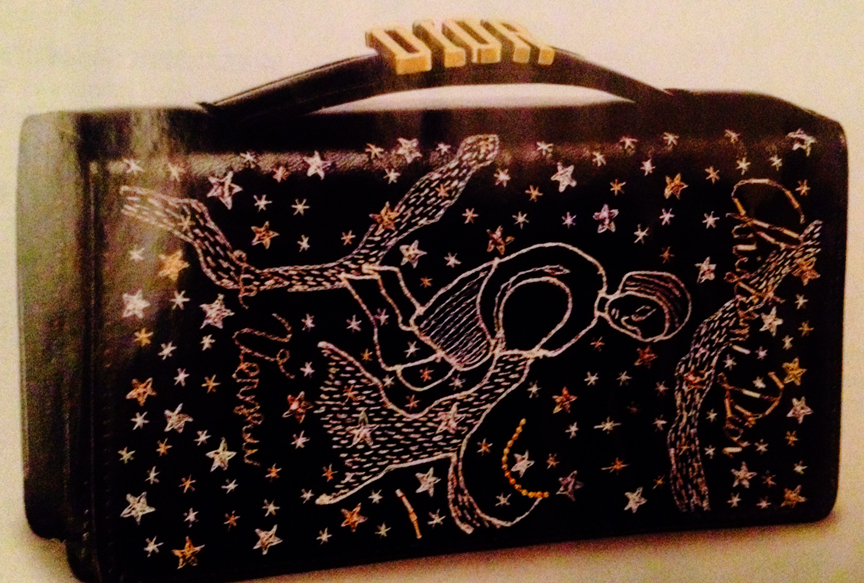
And I would carry this divine new Dior astrology clutch. It only makes sense. On off nights I might wear my hair in a large gristly bone or wear bone earrings. Wouldn’t that be fetching?
There are only a very few occasions when I am inclined, for a fleeing moment, to regret what I have done or not done and this is one of those rare instances. I do wish I could have darkened the doorstep of that historic Cave Under the Hill.

Thank you everyone for reading my articles and supporting me. It means so much to share this obsession with buildings and their people with all of you. I welcome your feedback and comments on the Cave Under the Hill, its history, and the area. I also welcome your kind corrections. We do know more together. To enable comments, please click on the header title. You can keep up with my latest investigations without even leaving your inbox, by “following” myomahaobsession. You will get sent email updates every time I have written a new story. Also join My Omaha Obsession on Facebook. Thank you, Omaha friends.
© Miss Cassette and myomahaobsession, 2017. Unauthorized use and/or duplication of this material without express and written permission from this site’s author and/or owner is strictly prohibited. Excerpts and links may be used, provided that full and clear credit is given to Miss Cassette and myomahaobsession with appropriate and specific direction to the original content.
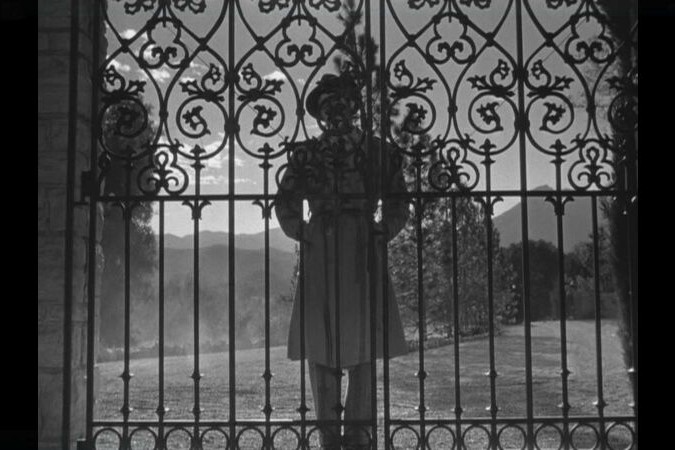
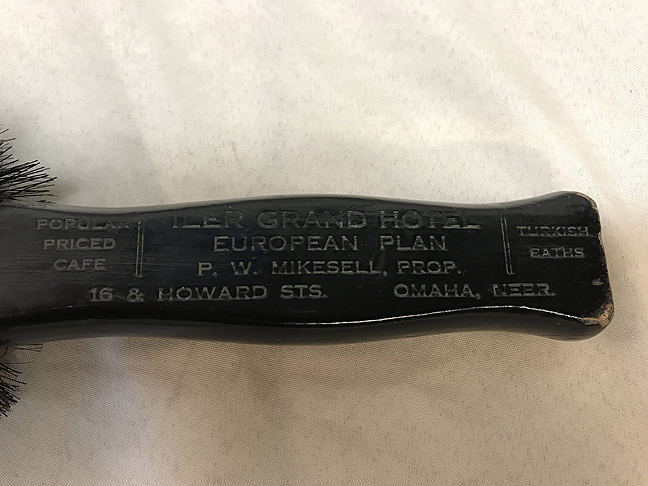
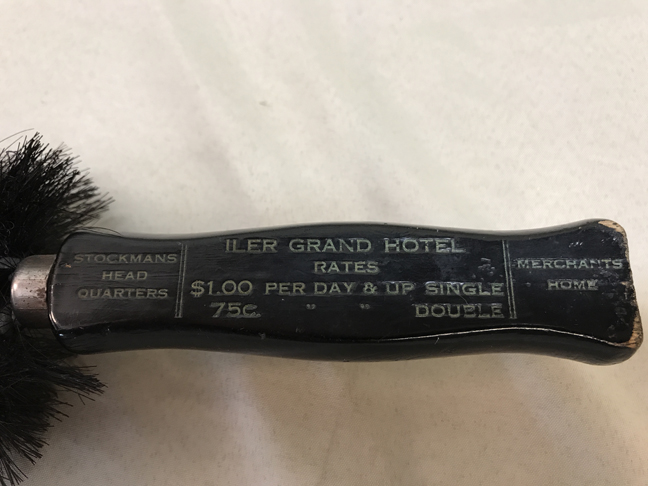
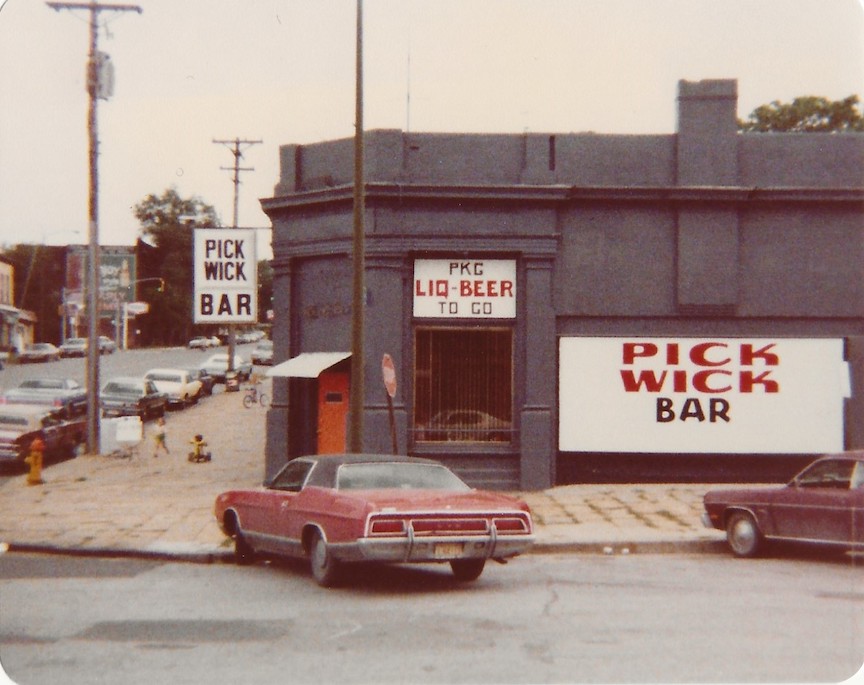
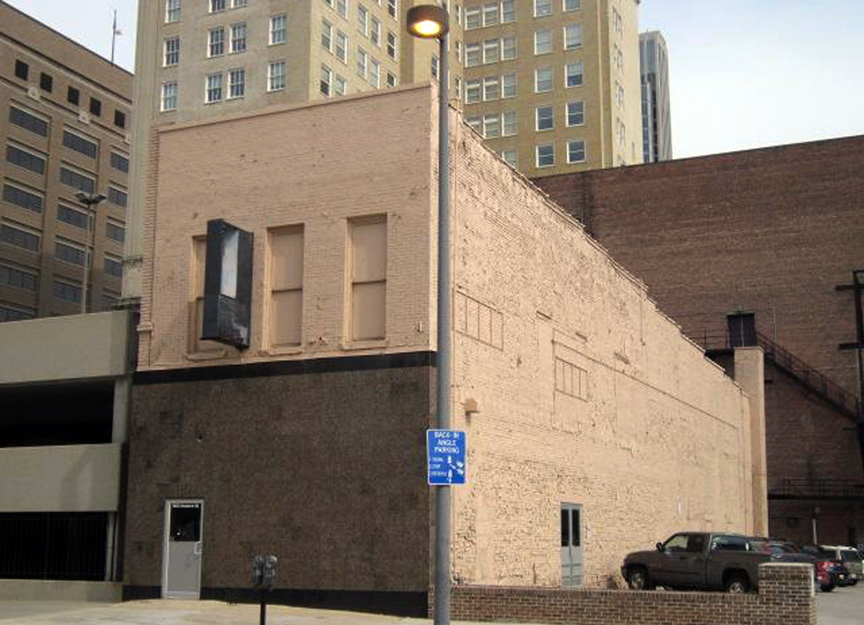
Fascinating history! I was dancing at The Cave in the years after ’77. One thing I can add that you’d enter the door to right of the main door of the hotel. At the bottom of stairs, the club was the the left under the Hill not to the right under the annex. Also at the far end (probably under the Howard St Jack and Jill Space) was another staircase that was closed off at the top as far as I could tell.
Kevin, thank you so much. This is good information and I must add you in as detective or informant or something in a revision tonight. As always, I appreciate your input.
Good one. Thank you!
Great story. I was fortunate to have been involved in the conversion of the Hill into apartments in the late 80s as well as the Aquila, the Securities building up the street and many others. I can recall unearthing ceramic tile in the basement and had assumed I the was remaining from the steam baths. The firm has a lot of photos of the building before demolition as part of the national register tax credit process (Alley Poyner).I’m sure they would dig them up if you asked.
Oooh I love this. The tiles. I must know more! Thanks for the tip. I appreciate this.
Went to the club under the hill in 1968 and 1969. It was called the Pepperment Cave y some. Mostly danced by jukebox. They where bands some nights. It was then a guy club but this didn’t bother me. Had a lot of fun nights there.
When I first logged on to read this (great work!), a comment with a video showing the Cave created by someone from the Bemis Center for Contemporary Arts was included. I clicked to start the video but things went wonky and I could only hear the audio, not see the video. Now, after re-loading this page several times, I don’t even see that reader comment and video. Using Firefox as my browser may be involved, as it continually stops loading of this blog asking me if I want to “de-bug” things. Too much information, I realize, but I’m hopeful the Bemis video can be viewable as just a link to YouTube rather than embedding it as I’m sure many will want to see it.
Thanks. Good to know. I had attached the link and it magically embedded the actual video, which wasnt my intention originally. I will work on it tonight. Thank you!
Have you ever looked into the history of the home at 830 No. 89th Circle? I drove by it the other day and it looks fascinating. Large white home built in 1900 on a circle with several mid century modern and new homes.
Hello,
I don’t believe I know it by its address. How exciting. I’ll drive by. Thanks for the tip!
Hi there! Wonderful history! Long story short I was going through boxes of collectables that I haven’t looked at in at least 20 years and came across an interesting item. I do not recall buying this so it must have come from my grandparents (they were born in 1911 & 1916). Anyway, it is a brush of some type, possibly one that was used on shoes, a fan, or…? and on the handle it states a lot of interesting information. On each side of the brush handle there are stamped words as follows: “Popular Priced Cafe” on the left and in the center, “Iler Grand Hotel”, “European Plan”, “P.W. Mikesell, Prop”, “16 & Howard Sts”, Omaha, Nebr”, then on the right side “Turkish Baths”. On the opposite side of the handle are the stamped words, “Stockmans Head Quarters”, then in the center, Iler Grand Hotel”, “Rates”, “$1.00 Per Day & Up Single”, “75c. “” “” Double” then on the right “Merchants Home”. I assume this was a brush given to people at the hotel or possibly one that people could buy. I also have a very old Fuller Lint Brush that was with this one, but it doesn’t have stamped info on it like the other one so not sure they are related other than coming from my grandparents.
So cool, Robert. Could you take a photo (cell is fine) and send it to my email address? myomahaobsession@yahoo.com. I would love to include it in the story. If not, it’s fine– and I thank you for taking the time to write!
Oh my word — this post set a new standard for ‘in-depth.’ I wanted to share an old photo of the Cave entrance that I came across… perhaps 1974, based on the Ford Pinto in view. Link: https://imagr.eu/up/WaVUr_Cave.jpg
This is fantastic! Good one. Did you take this, Steve? If so, I can include it in the story and give you credit. Let me know. Thanks
Not mine, but thanks for offering a credit.
so interesting discovering your site …. I wish I could have gone to the cave too! My Dad, John Roberts, played with the Elton Worth Orchestra in the 40’s. He must have played a few times at The Cave. thx for the info.
Happy New Year’s! Thanks for writing in. How very cool to have a musician father. I do love the 1940s! I hope you will pop in again–I have taken some time off to finish my book but hope to get back at it again (the website) in the late winter. Take care.
This article was amazing. I was going to UNLA in the early 70’s and we would come up from Lincoln most Saturday nights even through snow storms and tornado warnings during the 70’s. One of my memories of the Cave was that when you went to the restrooms there were 3 swastikas in the inlaid tiles leading to the bathrooms. The story goes that it had been a meeting place for the Nebraska Socialist Party in the 1930s. Love to hear more about this or anyone else remembers this. Thanks for the great walk down memory lane.
Very interesting read. I was the assistant manager for NP Dodge for Kensington Tower and Orpheum apartments from the late 90s to early 2000s, I too saw the swastika tiles in the basement. I also heard that it was a meeting place in the 30s. Also heard tgat it was a gay club at some point. Would love to go back and see it again. Beautiful grand building.
Hi.
Fascinating article. I was a regular at the Cave from 1973 to 1978 when I left Omaha to move to California. There was only a juke box prior to it becoming a “disco” around 1975 with a dj spinning records. You had to get there early to put money in the juke box to play something good to dance to before the lesbians took it over and played country western music. There was a pool table, a phone booth, and I believe a coat check at the bottom of the stairs as you entered the club. For a short period there was another “elite” gay bar on the right side of the bottom of the entry stairs on the Iler side called “The Den of Iniquity” I think it was a private member club, or you needed to be invited in by a member or by the bar’s manager, Donny Wingo. He’s the person you should really try to find and contact. I’m sure he can tell you everything you ever wanted to know about the Cave and the Hill Hotel. He must be in his mid to late 70’s by now if he is still alive. Many great memories of that era and of the Stage Door also. We would go back and forth between the two. The Stage Door had either yellow or orange shag carpeting on the walls and floor. A friend of mine use to call it
“The blushing big bird lounge”. We were all so thrilled when the Hollywood Disco opened in 1978, but I was sad to learn that it only lasted a few years before they tore down the building it was located in. Anyway, please see if you can find and contact Donny Wingo if he’s still around. Great work, and Good luck!
Love your website. Does anyone remember was a man named Sam Soda a manager of a bar in the early 80s called the Stagedoor? All I am trying to do is confirm that he worked there. Does anyone know if a man named Sam Soda was a manager at the Stagedoor? This would be sometime in the early 80’s. Thank you.
I was looking back for some memories of places I used to live in, when I came upon your interesting blog.
I moved from NYC to Omaha, in November of 1971.
My first “home” was temporarily in the Castle Hotel.
After dinner, I decided to check our some of the nearby bars, and one night, I ventured down the stairs, to The Cave Undet The Hill. I didn’t notice that it was a gay bar, until one patron greeted me: “Hi, handsome”. Then another scolded him, saying “hey, I saw him first”…
As soon as I realized my mistake, I made a hasty retreat up to the exit. I was very uncomfortable at the time, but now can laugh about it… 🙂
Your article brings back some wonderful memories of many nights spent at the Cave. Meet my first love there…and still think of Jeff to this day. I remember the first few times going there and trying not to be seen going in the door. And then walking down that flight of stairs into a dark mysterious place. And then after awhile I didn’t care who might have seen me going in or out. The music was great and it was always a mix…fast dances and then slow dancing mixed in. I miss that today. And there were so mant wonderful characters. I had a great friendship with a very well-known Omaha hairdresser, Donny…his clients were the who’s who of women in Omaha society. And at the end of the evening some DJ’s would play Gloria Gaynor’s “Never Can Say Goodbye” and we would all pour out of the place and head off to either The Ambassador Cafe or to The Village Inn on Dodge. One night a few police officers came into the place, shook people up, they just walked through but there was always talk about a police raid. And in a group that I knew there was an oldr women who came with them and we always called her Mother. She was so much fun! Thanks again for the article and opening the door to these wonderful memories. If anyone wants to talk further about the Cave or those early ‘Gay’ days in Omaha I’d be happy to.
I googled The Cave in Omaha and came across your article. I had been asked about my first gay bar. I went to the Cave in the early 70’s while in college, at Wayne State. I went there from 1971 to 1975, so the Cave was indeed gay in the early 70’s. Your photos brought back memories. I imagine you could not find much about it being a gay bar as back then, gay life was all underground.
thank you for sharing. I moved to omaha for my first job out of grad school and love learning about the queer history here.
My wife and I were remembering one of our first dates at the Peppermint Cave in late 65 this morning and I decided to do some research on the Cave and came across your site. Very nice.
It was wonderful to see my late departed friend Dave Trupp highlighted and his bands. Dave died a couple years ago of a lung embolism. I taught Dave how to play drums in our basement on 59th St during our Benson High School years of 58-61. Dad would throw open the basement door every so often and tell Dave to “play a different riff!” as Dave would play one certain riff over and over for long periods. Ha.
Dave would walk 9 blocks from his house near Benson High to our house to be able to practice in the basement. I was busy with studies at UNO and playing weekend gigs myself and never really caught one of Dave’s band nights at the Peppermint Cave, even though I would hurry down there to catch the last set of whoever was playing after some of my gigs if time allowed. Dave and I stayed in touch for all my Air Force and airline career years and would always chat about the Peppermint Cave days.
My dad, Merle C. Overholser, was considered one of the best drummers in the Midwest and I wound up playing with many of the musicians in his age group around Omaha. Wendall Hall, mentioned earlier in the blog, was one of my dad’s best friends. They met when Wendall was playing with Lawrence Welk. Welk also wanted my dad in the Welk band, but mom and dad were dating at that time. She had graduated from Buena Vista college in Storm Lake, IA and wanted to move to Omaha……..so they got married and moved to Omaha…….and the rest is history. I was the first born.
I remember all my Omaha years very fondly.
I started going to the Cave as a gay club in 1970, and it was established as gay about a year before that. Just saying it began as a gay club earlier than you stated. Before that yes the bar upstairs was gay, but that was too exposed and I was too young. I would go to Gino’s lounge on the opposite corner from the hill on Jackson street, then sneak down to the Cave when I was brave enough.
I have special memories of this spot. I was in a band from about 1963 to 1967 called “The Rogues” The Cave Under the Hill was a regular gig spot for the band, we played there about once a month. Don Hammond was managing the teen club and always treated us very kind. Enjoyed the article and all the pictures. Thanks…!
The Rogues! Yes, how cool. You are famous in these parts. We would love to hear anything you would like to share about the Cave. Thank you for writing in.
I fell down an internet rabbit hole about the Old Market “underground” and remembered in the late 90s hearing rumors of raves and parties being held in tunnels and caves underneath downtown Omaha. I spent many weekends as a teenager in ’98/’99 trying to find these parties but never did. I wonder if perhaps this cave, or others nearby, are held in private for private parties, at least were as late as the late 90s.
The story never ends.
We look into the past to find the truth and understand.
Love & Peace
Mayor of Benson
The Mayor himself! I miss you. I miss our talks. Wishing you good health.
Hello! I was wandering down memory lane a few days ago and thought I would attempt to find out what happened to my most favorite “haunt” of my 20s. I am now 75 and live in California. I was rather dismayed to see that practically nothing remained on -line regarding The Cave…then I saw your most delightful and informative article!! Excellent work by you..and details I had never even imagined. I do not know if I can add anything to your quest on things relating to The Cave, as I have no photos, etc. However, The Cave in the 70’s was most definitely gay. The decor was as you mentioned….except there was a mirrored disco ball on the ceiling of the dance floor. It was a very friendly and open place to be for gay folk. The men usually sat on the right side of the room and the women on the left. It was, as you mentioned one room..you did enter down a flight of steps, the bar was on the left…there was a stage at the far end of the room with the DJ up to the right side of it…excellent music of the time…I left in 1978 and moved away, but I did spend a lot of happy years there from about 1973 to 1978.
We felt safe there…had to walk near the fire station located close by to get to it, and sometimes the guys would hoot a bit of us..but I never felt threatened. It was a safe and fun place for us. Not only was The Cave a friendly and safe place to be for gays…it was also that way for straight folks…although I don’t remember too many straight people in attendance…I took a couple straight friends there and they had a fine time too. So, I think if someone with a good attitude had wandered in..they would have been fine…but, it was not a mixed, straight and gay crowd; it was a gay place. To my eye, there was no issue between the gay guys and the lesbians…we had a few trans people there also…men and women. I just don’t remember much, if any, divide between us. As I mentioned, there was a stage at the far end of the room…with the DJ up to the right of it…But, I don’t remember any stage shows, per se. Just can’t remember much of anything happening on the stage…just music and dancing on the dance floor. I had left there in 1978 and ended up in San Francisco..and started “clubbing” in that city. In retrospect, The Cave was way before it’s time…it would have stood up well anywhere for inclusiveness and fun. Again, thanks so much for doing a piece on this!!!! Oh, I think you mentioned in your article that perhaps the outside entrance with the stairs going down from the street (the photo of The Cave is spot-on)…was an add-on for another ingress/egress and was added on for a better way out in case of a fire…I have thought, on occasion, that The Cave would have been a very bad place for a fire to break out, because that way up the stairs would have been pretty tricky if people had to evacuate in a hurry…Thanks for doing such a great job investigating this, it was an excellent article by you…!! Thank you for providing the photos too. You helped an old gal take a very fine walk down memory lane. I had no idea that this place had such a rich history! Thank you…Nancy
I think you’d find Robber’s Cave in Lincoln interesting. It’s an actual sandstone cave that has had quite a history of partying, music, dancing. I wrote a book on it “Robber’s Cave: Truths, Legends, Recollections and there’s a documentary being made on the book. Tours are everyday. There was a dance floor installed in the 1920s, I even hosted a Freemasons event in the cave a few years ago. I could send you photos. There’s a few articles about Robber’s Cave if you just Google it. One was front page OMH and another front page in LJS. Get a hold of me if you’d ever like a tour.
I had gone to the club when they opened to teens, just before it shut down.
Omaha was not gay friendly and the police took great pleasure in trying to rid downtown of gays.
Winklmen was also anti-gay.
When I was at the restaurant I had met him and he showed me and talk about the different framed stamp about the walls.
He bought with the Aquila Court, the Diamond bar and as quick as possible, had it taken down as fast as he could for an additional parking for the Aquila (ok)
He hired is nephew in a tow truck to drive around chasing anyone off the lot (The time of the milk run) the lot was very much a cruising spot for gays .The nephew would pull up and yell “fucking queers get the fuck out of here.”
About the Cave– you could also take the hand operated elevator downstairs
Also there are stairs on the side of the elevator
Also upstairs on several of the floors they rented rooms by week or month–lots of single men live there
Enjoyed reading the story
One day I will send you the story of meeting the dancer his Dad was president at the time
That was a strange night
Take care
I happened upon your great story. My Dad was a musician with a trio, The Tune Criers They traveled for 6 yrs across and back most of the states. The Hill Hotel was one of their stops in 1952, the year of a big flood. I have a great photo of Joe, the bass player standing outside next to the sign the Cave under the Hill. I thought you would like a copy of that.
Yes, please! This is so great to hear and I’d love to see that photo and include it in the article, if that is OK. Please send it to my website’s email account. myomahaobsession@yahoo.com. Thank you so much
I need to send the photo over email to where?
Thank you! myomahaobsession@yahoo.com
My mom, who graduated from high school in 1938, had her first legal drink–a rum and Coke– at The Cave Under The Hill.
Great article! Very interesting stuff! As part of my research into the history of Omaha’s tropical / tiki bars, I’ve been focussing on Don Hammond’s 7 Seas, amongst others. The March 27, 1957 World Herald reported that Hammond had sold that 7 Seas to Lawrence Welk regular Gene Purcell – which corresponds closely with your impression that Don Hammond was managing The Cave by 1958. However, like you, I can’t find any proof that Hammond was employed between selling the 7 Seas and The Peppermint Cave help wanted advertising in May 1962 – just vague evidence that he may have been trying his hand as an events & entertainment producer. He’s listed as a judge in the 1959 Miss Omaha pageant; as co-producing a July 4 Family Fair in 1960 with theatrical agent / promoter Don Romeo; and finally a mention of “Don Hammond Productions” in a 1961 ad for the premiere of the Redhead Lounge.
Just saw this! The Cave was my first gay bar. I moved to Omaha from western Iowa after serving two years in the army. In the early spring of 1972, I nervously but excitedly walked down those stairs to see men dancing with men and women dancing with women. I was all in!
Thank you so much for writing in, Jim! I do love to imagine those days. Thank you for sharing.